#conch snail hours
Explore tagged Tumblr posts
Note
*carefully picks you up and peeks into your conch snail shell*
Ehm... Sorry to bother, but... Could we, maybe, possibly... see Vasco's wife and her lover pictured by your hand? Sorry again, thank you for listening. Take care.
*delicately lays you back into the water to prevent any stress or dehydration*
Unfortunately I don't have her lover figured out yet, but I think Ludovica looks something like this:
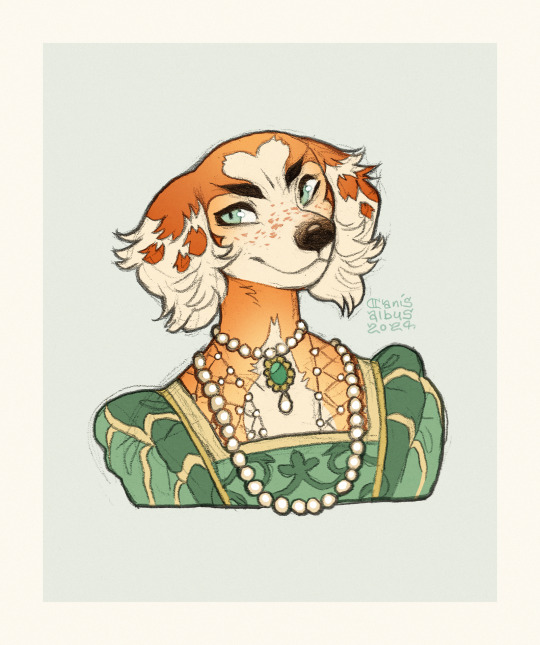
#own art#own characters#CanisAlbus#Ludovica#vertopus#Vaschete lore#I may still tweak the markings this isn't 100% guaranteed final design#might make her colors a bit more reddish perhaps#but you know this is the general vibe#she was originally inspired by brittany spaniels and one of my old unused characters#to be fair the whole thing was built around the idea that she should have strong eyebrows and green theme color#again jury is still out on the renaissance hairstyle/head piece I'll try to come up with something#still trying to get a good grasp of the girlfriend too#she's most likely her lady-in-waiting or other court companion#essentially a woman of high social class whose job is to accompany a noblewoman and assist her on her daily activities#a best friend more or less#conch snail hours#she will kick anyone's ass. she will kick your ass. she will kick your dog's ass. she will kick her own ass.
4K notes
·
View notes
Text
Come tide pooling with me!! ╰(⸝⸝⸝´꒳`⸝⸝⸝)╯
We flew in at maybe 8am and immediately went to beach- 6 hours before low tide o(-( sat there for a while to finish up the comic!! And then! Saw dolphins!!!!
There were maybe like 3 that came up? Saw them do their little blow hole thing and then they went off into the distance 🥹 starting off strong!!
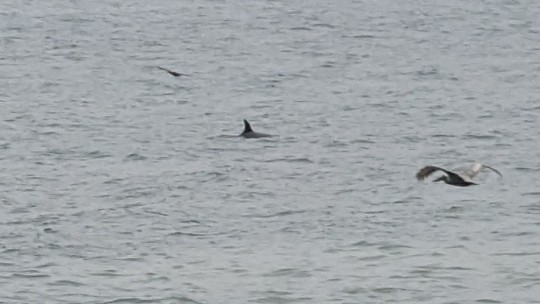
And then after a couple hours we got cold and went to a nearby cafe for snacks :9 came back an hour before low tide
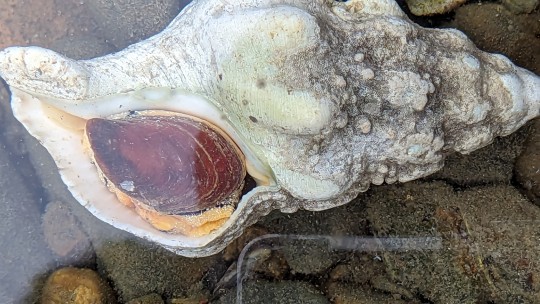

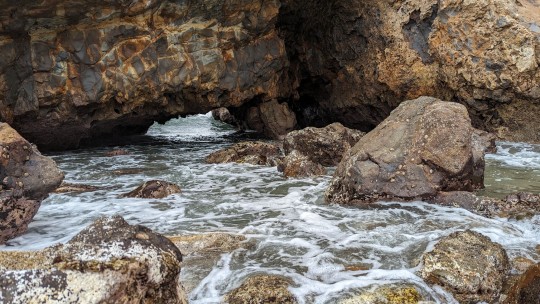
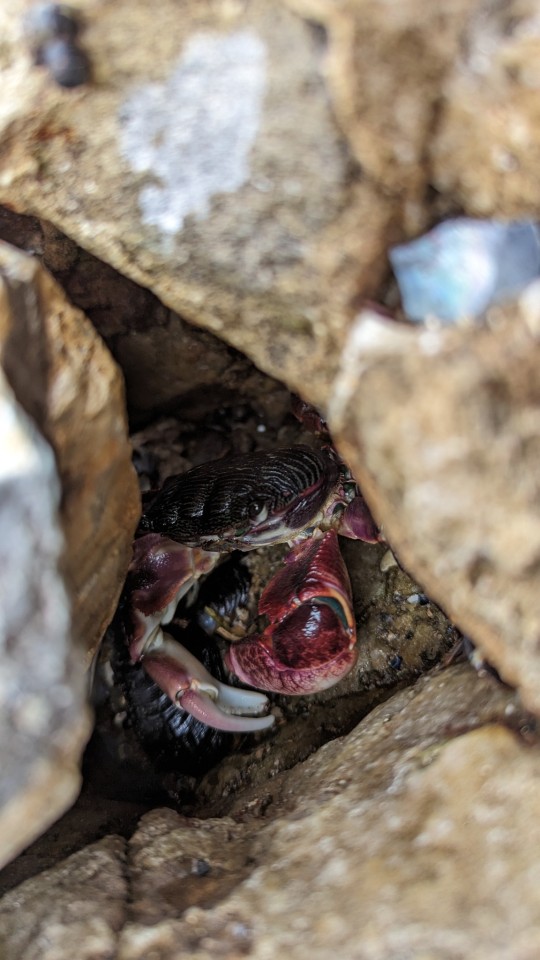

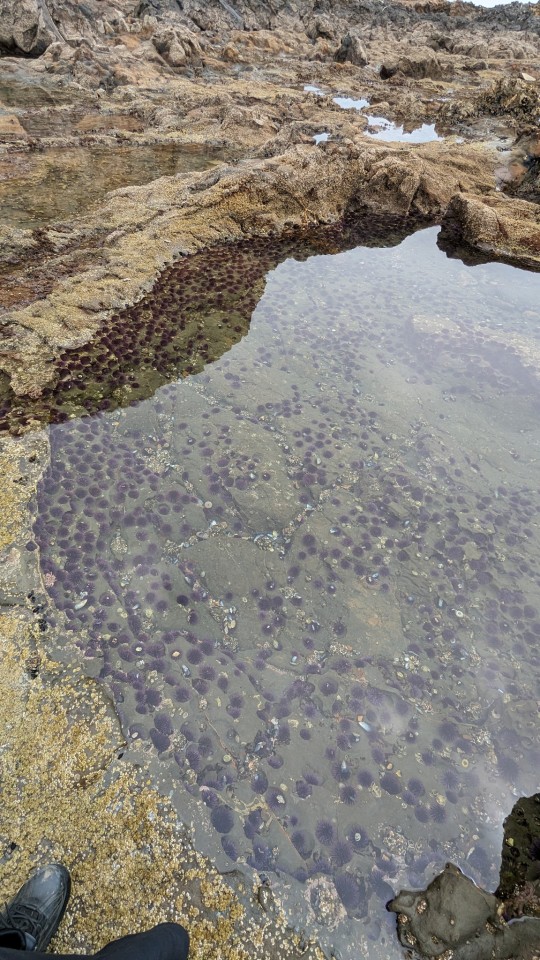
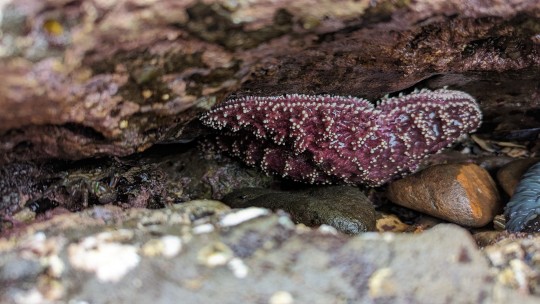

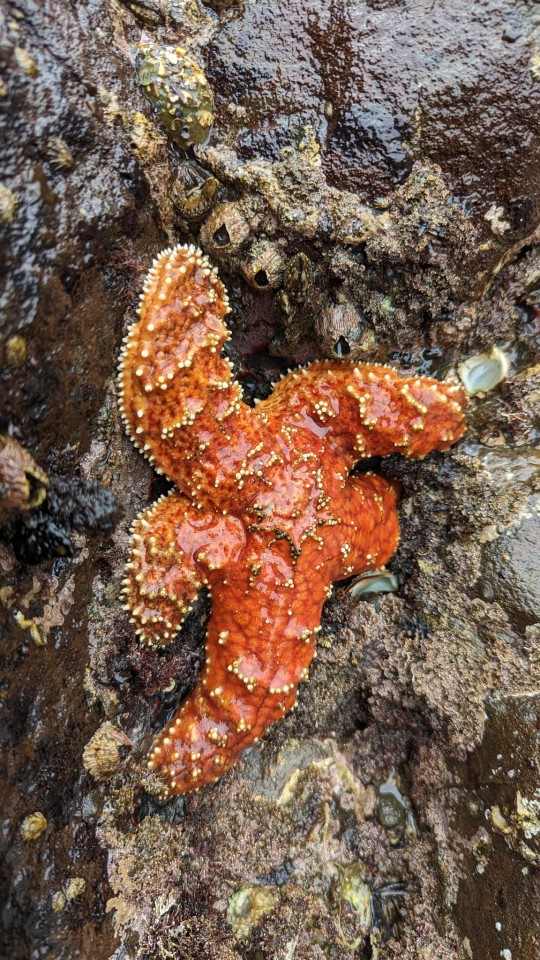
saw a lot of crabs and sea stars, anemones, and hermit crabs!! A few conches and a lot of turban snail shells 😭 Also saw a crazy amount of sea urchins o)-( !!!
seals were still there when we left (*´︶`*) !! Very nice day
Despite all the climbing we had to do to get there and back
#hello yeo#i just got home hehe#we were hoping to find some sea hares but no luck ; o; maybe next time#we did see a lot of wild rabbits tho :D !!!#we got so lucky with all the animals we saw (´°̥̥̥̥̥̥̥̥ω°̥̥̥̥̥̥̥̥`)
62 notes
·
View notes
Text
abyssal eternity ೃ༄

cw: fantasy whump, female whumper, siren whumper, human whumpee, hypnosis, mind control, character death (non graphic)
── ── ── ── ⋆⋅☆⋅⋆ ── ── ── ──
A slight breeze brushes through whumpees hair as they make it past the small forest path leading to the beach. Them and their family rented a vacation house on a small island just for themselves. It’s already evening but they really wanted to take a small trip to the beach.
It looks like it’s gonna rain in half an hour or so, clouds building up on the sky and even darker ones can be seen across the horizon. Maybe it’s going to storm.
Despite the upcoming weather the coast looks beautiful. Whumpee takes off their flip flops and allowing their soles contact with the sand before they step towards the water. Small fishes swim away from them as they walk in until the water reaches up to their ankles. They don’t want to go in too far. As a child whumpee almost drowned because they got too curious. So they are extra careful now. They quickly take the camera, held by a string around their neck before snapping a picture of the horizon.
As they watch small waves gently hitting them over and over again they notice something in the water. Whumpee bends down before they pick up their discovery. It’s a seashell. A beautiful white conch. But it shines in slight rainbow colors if you look at it from the right angle.
Whumpee looks around more. There’s barely any people on the island over the year, since apparently it’s pretty unpopular. So there have to be a lot of beautiful shells since no one can take them.
And whumpee is right. They find another shell. This time a big scallop. The curious whumpee steps towards the shell and picks it up before they find another… and another! Woah another one!
They look on the ground as they follow the shells on the floor, stuffing them in their totebag. The sandwich they packed is probably ruined by now as almost half of the bag is full of the shells but whumpee doesn’t mind. It’s a small sacrifice for those beauties.
After some time whumpee looks up again. They’re standing in front of a stone wall of a cliff. As they look back they noticed that they passed the large stones that seemed like a dead end. But as they turn their head around again they notice some even more interesting. It’s a big hole in the wall. An entrance to a cave!
Curiosity takes them over before they head inside. It’s dark.. they should have brought their phone for the flashlight. Their footsteps echo through the dark tunnel before they see some light, picking up their speed.
Whumpee can’t believe their eyes as they enter the cave. It’s beautiful. There’s glowing crystals all around and small puddles with snails and mussels in them. They take their camera again before taking another picture of the cave.
Suddenly. A soft melody, a little further in the cave, catches whumpees attention. They immediately grow scared. There shouldn’t be any other people on the island. Their instinct tells them to head back but… they really want to see who that gorgeous voice belongs to.
So they walk forward. Further into their magical discovery, heading through another shorter tunnel before they enter a smaller cave.
The first thing they notice are the numerous items around the entrance. Clothes, jewelry, cutlery, vases, books, accessories. Anything that looks valuable.
As whumpee steps further they see something that looks like a small lagoon with beautiful turquoise water. And sitting, with their back facing whumpee, is a woman with long black hair and pale skin, still singing the beautiful melody.
Whumpee picks up their camera a third time before they snap another picture.
And that’s when the singing stops…
“Is that a visitor?”
The woman calls before whumpee takes a small step back.
She turns her head around, revealing a face just as gorgeous as her singing. And her deep turquoise eyes… mesmerizing.
“Oh please do not be afraid. I don’t bite sweet pearl.”
She purrs before lifting her hand, her nails are long and it looks like she has small finns between her fingers. The woman curls her finger, motioning for whumpee to come closer. It almost feels like their legs move on their own and they step forward.
The woman smiles and slowly slides down in the water and what whumpee sees behind her makes them gasp. Instead of two legs, she owns a long dark green tail. Shiny scales covering it.
“Sweet Summer Child I told you to not be afraid. Sit down. I do fancy some company.”
Her soft voice makes whumpee feel saver immediately. This is weird… but she’s so pretty… they don’t want to never see her again. So they obey her request. Sitting down on the wet stone, letting their bare legs sink in the water as the woman swims closer to them, leaning her upper body on another stone.
“Oh how awfully rude of me to not make an introduction! My name is whumper. What about you darling?”
Whumpee swallows before answering the lady.
“Whumpee”
Whumper hums before making a small giggle.
“Beautiful! It fits you just perfectly.”
She smiles up at whumpee, her expression looking seductive but still innocent in some way.
“What… are you?”
They ask shakily and the woman spins her body elegantly so she’s lying on her back, flapping her tail slowly, making a few tiny waves in the water.
“I’m a siren, child.”
A siren… those aren’t good. Well from the fairytales and fantasy stories whumpee has heard before they know that at least.
Whumper stretches a little before she crawls a bit closer to whumpee, gently brushing a finger over their slender legs.
“So pretty… what is that?”
She asks as she looks at whumpees camera. It’s not something humans usually wear on them. It’s no necklace or scarf… so it awakens the woman’s interest.
“Oh-.. it’s my dad’s old camera. He gave it to me.”
Whumper tilts her head. Looking just as confused as before.
Whumpee picks it up before pointing it at the siren.
“You press on that little button up here.”
They press down on it and the snapping sound comes.
“And it takes a picture.”
Whumpee selects the picture they just took before they turn the camera around, showing it to whumper.
“A mirror?”
She asks and whumpee shakes their head as they make a small giggle.
“Not a mirror. It’s a picture of you. It… freezes the moment and you can always look at it again.”
That peaks whumpers interest more and she smiles, her teeth look sharp. She hums again before sinking down in the water, leaving her head above it.
“Do you want to swim with me?”
Whumper asks softly and whumpee immediately grows nervous again. They shake their head.
“No…”
The siren frowns for a second before she swims a little closer, gently caressing whumpees leg again.
“I- um-.. I should go-“
Whumpee says as they pull their legs up again but whumper quickly grips their ankle, looking up at them with wide eyes before turning to their seductive expression again.
“But do you want to go?…”
Whumpee looks down at her worriedly, not answering her, which makes whumper let out a soft chuckle.
“No you don’t want to go… you want to stay here… with me…”
She gets even closer.
“You love me whumpee… don’t you?”
She asks them and they nod. Any sign of fear or worry having completely left their face.
“Yes… I love you whumper.”
She smiles before planting a wet kiss on their thigh.
“So where is the issue? Have a swim with me”
Whumpees mind feels blurry. They can just think about the siren. Her beautiful body, plump bare breasts, her pretty face and her long hair.
So they do it, slowly sliding down into the woman’s arms, down in the water.
She’s taller than whumpee, holding them gently as she looks down in their eyes before moving to kiss the completely mindless thing. Pressing her salty dry lips against their soft ones, making euphoria rush through their veins.
They don’t notice the danger they’re in.
They don’t notice themselves being slowly pulled under the surface.
They don’t notice the water entering their lungs as they breathe in, still looking at whumper.
They start to choke but all they can think about as everything turns black, is the love of their life.
The end of their life.
── ── ── ── ⋆⋅☆⋅⋆ ── ── ── ──
Phew this turned out longer than expected. I hope you liked it thoo!!
@a-living-canvas
@watermelons-dont-grow-on-trees
@theforeverdyingperson @stuffandthingsandandrew
#whump community#whumpee#whump#female whumper#siren whumper#fantasy whump#hypnosis#mind control#human whumpee#character death
22 notes
·
View notes
Text
Top Ten Must Try Caribbean Dishes
Content Source : In the Kitchen with Alexandra

Let’s Talk Caribbean Cuisine!
Imagine a place where flavors collide in the most beautiful way — welcome to the Caribbean! This region is more than just stunning beaches; it’s a hot spot of culture and history, and its food reflects that melting pot perfectly. With influences from Africa, Europe, India, and the indigenous peoples of the Americas, the Caribbean’s food is a mouthwatering adventure. Today, we’re diving into ten iconic Caribbean dishes, and trust me — you’re going to want to try them all!
1. Jerk Chicken (Jamaica): Spice Lovers, Rejoice!
Jerk chicken is one of those dishes that packs a punch, and Jamaica is where it all began. The magic lies in the jerk seasoning — a fiery mix of allspice, Scotch bonnet peppers, and other aromatic spices. The chicken gets marinated in this spicy goodness, then slow-cooked over pimento wood, which gives it that deep, smoky flavor. And if you’re having jerk chicken, you’ve got to have it with rice and peas, a delicious combo of rice, kidney beans, and herbs.
2. Mofongo (Puerto Rico): The Ultimate Comfort Food
Mofongo is Puerto Rico’s version of a warm hug on a plate. This dish is all about mashed plantains mixed with garlic, pork, or shrimp. The plantains are fried to golden perfection, mashed, and then shaped into a ball. Sometimes, that ball is stuffed with savory broth or stew — either way, it’s filling and fantastic!
3. Ropa Vieja (Cuba): Shredded Beef Heaven
In Cuba, “ropa vieja” means “old clothes,” but don’t let the name fool you! This dish is pure deliciousness. Shredded beef slow-cooked in a rich, tomato-based sauce with peppers, onions, and olives creates a stew that’s both hearty and comforting. Served with rice and plantains, it’s a meal that hits all the right notes.
4. Callaloo (Trinidad & Tobago): Leafy Goodness
If you’re craving something green and packed with flavor, callaloo from Trinidad and Tobago is your answer. Think of it as a leafy stew made with spinach or callaloo leaves simmered in coconut milk, tomatoes, and spices. It’s rich, flavorful, and often a favorite for vegans and vegetarians. Pair it with rice or bread, and you’re in for a treat!
5. Oxtails (Jamaica): A Stew That Steals the Show
Oxtail stew is a Jamaican favorite, especially at big family gatherings. The oxtail is slow-cooked with a mix of spices — sometimes including jerk seasoning — until it’s tender and falls off the bone. It’s served with rice and peas or plantains, and it’s known for its deep, rich flavor.
6. Accra (Trinidad & Tobago): Crunchy Fritters
Accra is a street food staple in Trinidad and Tobago. These crispy, deep-fried fritters are made from saltfish (or cod), chickpeas, and spices. They’re perfect for a quick snack and usually come with a dipping sauce for that extra kick of flavor.
7. Jamaican Patties: The Perfect On-the-Go Snack
Craving a savory snack? You can’t go wrong with Jamaican patties. These golden pastries are stuffed with spicy beef, chicken, or even veggies, making them a popular street food. Easy to grab, easier to eat!
8. Conch Fritters (Bahamas): A Seafood Lover’s Dream
In the Bahamas, conch fritters are where it’s at. These little bites are made from conch meat (a type of sea snail), mixed with flour, herbs, and spices, and then deep-fried to perfection. They’re often served with a dipping sauce and are a must-try appetizer.
9. Mangu (Dominican Republic): Breakfast, but Better
If you’re in the Dominican Republic and someone offers you mangu for breakfast, don’t hesitate! This hearty dish is made with mashed plantains, fried cheese, and salami. It’s also common to see it served with avocado and onions — trust me, it’s a breakfast that will keep you full for hours.
10. Griot (Haiti): Crispy, Flavorful Pork
Griot is a beloved Haitian dish made from marinated pork that’s fried until crispy on the outside but tender on the inside. It’s usually served with rice, plantains, and pikliz (a spicy pickled vegetable mix). It’s a celebration of flavors that’s totally worth trying.
The Story Behind the Food
The food of the Caribbean is a reflection of its rich history. When African slaves were brought to the region, they brought their culinary traditions with them. Add in the European colonizers with their ingredients and techniques, plus the indigenous peoples and their local produce, and you’ve got the perfect recipe for culinary fusion. What we taste today is a delicious blend of all these influences — truly one-of-a-kind.
Wrapping Up Our Flavor Journey
Caribbean cuisine is a feast for the senses — there’s spice, comfort, and a whole lot of heritage packed into every bite. Whether you’re savoring the bold jerk chicken or the satisfying griot, each dish tells a story. So next time you dive into one of these meals, remember that you’re also getting a taste of the Caribbean’s rich, diverse history.
Discover more delicious and exciting recipes on the blog: https://inthekitchenwithalexandra.com/
0 notes
Note
I don't care about everyone else! i care about you, SQUIDWARD! (simping softness asks)
For those who don’t know, my ask box is open. Send me a simping softness prompt, and I’ll write a short sbsp ficlet for you. ✰
so, uh -- i might have gotten a bit carried away with this prompt. it’s definitely longer than a ficlet, but oh well. either way, it was a lot of fun to write! selfish spongebob is so rarely explored.
fic under the cut. also, just in case, cw: drinking, drunkenness, etc.
Spongebob rose bright and early, long before his foghorn alarm went off at 7:00 a.m. With a cheerful shout, the poriferan jumped out of bed, earning a disgruntled “mrow” from Gary, who was still asleep nearby. Stretching vigorously, the sponge leaned down, planting a soft kiss atop the snail’s shell.
“Gary,” he whispered, practically vibrating with excitement. “Today’s the day!”
Turning away, Gary simply replied “mrow”, in a disdainful way that most certainly meant “whatever.”
Undeterred, Spongebob ran to his calendar. Sure enough, the day’s date -- July 14th -- was circled in bright-red, permanent marker, with the words “My birthday!” written neatly across it. And just below those words, was a tiny drawing of Squidward’s face, with dozens of little red hearts surrounding it.
Making his way over to the window, Spongebob gazed out at Squidward’s moai in the distance. He sighed, dreamily. What was Squidward doing right now? Probably sleeping, in that adorable dress of his.
The sponge lingered there, staring dazedly out at the moai, for perhaps a moment too long. Then, remembering himself, he sprinted to the bathroom. Once inside, Spongebob pointed a finger at his own reflection in the mirror.
“Enough beating around the bush, Mr. Squarepants!” he yelled -- much to Gary’s annoyance. The sponge lowered his voice down to a soft whisper. “Today, you tell him how you feel.”
His reflection simply shrugged. “I mean, okay,” it said. “But this is like, the 57th time you’ve said this.”
“Oh, shush.”
-0-
The party was supposed to start at 6:30, but Spongebob, in a manic cleaning fit, had the entire house ready by noon. This year, the party was themed around As The Tide Turns, a very polarizing-but-popular soap opera, especially in Bikini Bottom. If you were a Bikini Bottomite, you either watched the show genuinely, or ironically -- there was absolutely no in-between.
Spongebob and Squidward both genuinely enjoyed the show. It was one of the first things they bonded over, back when Spongebob started working at the Krusty Krab. Through the window to the galley, the two coworkers would talk for hours about the show, and whatever drama was center-stage for that season.
It got to a point where Mr. Krabs -- who only watched ATTT ironically -- got on them both, for shirking their duties.
“If yer gonna flirt,” he’d said, “do it on yer own time.”
So, Spongebob started coming over to Squidward’s house on Friday nights, when the new episodes would air. In fact, even when the show was between seasons, Spongebob still came over, just to watch reruns. It was one of the few times Squidward would (begrudgingly) let Spongebob inside, with no complaints.
Spongebob hummed softly to himself, his eyes scanning the small clipboard in front of him. Food, decorations, party games … Check, check, and check. Everything was present and accounted for -- and he had to admit, the house looked spectacular.
Every room was themed around a different, iconic arc in the ATTT series. His living room, filled with chalk drawings, crime scene tape, and red-string boards, was inspired by the murder mystery arc. His kitchen, decorated with leftover Halloween gear, was inspired by the vampire arc … and so on and so forth. Each and every room had its own particular, careful design -- and in all, it was probably Spongebob’s most intricate and detailed party to date.
That was because it had to be. Spongebob had a plan, a carefully detailed plan -- one that was sure to sweep Squidward Tentacles right off his … er, tentacles. And it went like this:
Squidward and Spongebob’s favorite arc, in all 42 seasons of As The Tide Turns, was the murder mystery. In the arc, the dashing Detective Heartthrob, accompanied by his sidekick-slash-lover Joey, must bring a heinous mass murderer to justice. At the climax, it is revealed that Detective Heartthrob is the true killer -- having been hypnotized by a witch, who was also his evil twin sister, for some reason. In the end, Joey must kill Detective Heartthrob, in a tragic display of love and sacrifice.
The season was thrilling, silly, and emotionally traumatizing, to boot. For months after the finale, Squidward and Spongebob would not shut up about it -- much to the annoyance of Mr. Krabs.
Either way, Spongebob had set up an elaborate, original mystery game, inspired by the events of the show. Each attendee would get a “random” card, assigning them a different role in the story. Squidward would be Detective Heartthrob, and Spongebob would be Joey.
Together, they would embark on an original mystery, one that Spongebob had devised all by himself. After he and Squidward solved the mystery together, and the party was over … Spongebob would finally, finally confess his feelings.
Of course, Spongebob had, more or less, rigged the game to ensure this would happen. Which was cheating, sure, but this was for love! So it couldn't possibly go wrong.
-0-
It went wrong. Almost immediately, in fact.
For one, the party started at 6:30 -- and, nearly two hours later, Squidward had yet to show up. Spongebob spent those first two hours lingering by the door, staring out the window towards the moai, and forgetting to refill the punch bowl. Sandy, ever the observant one, noticed immediately.
Pulling Spongebob aside, she asked, in a hushed voice, “Hey, partner. You good?”
“Oh, I’m -- I’m great!” chirped Spongebob, putting on his worst, most unconvincing smile. “Why wouldn’t I be?”
“Uh-huh,” said Sandy, flatly. “This about Squidward?”
Spongebob blushed, immediately. The squirrel sighed.
“I thought so,” she mumbled, folding her arms across her chest. “Did he say he was gonna come?”
The sponge nodded. “He said, ‘I’ll see if I can make it work’, which in Squidward-speak, is practically a yes!” groaned Spongebob, staring up at Sandy with his huge baby blue eyes. “He’ll come, right, Sandy?”
Sandy hesitated. She didn’t really know Squidward that well … but he did seem to have a soft spot for Spongebob. Awkwardly, she replied, “I mean … I can’t say for sure, but he did say he would try. Let’s be patient, okay, Spongebob? Maybe he just got caught up with something.”
Spongebob sighed, then repositioned his face into its usual chipper smile. “Alrighty. You do usually know what’s best, Sandy.”
“I sure do,” she giggled. “Oh, and Spongebob?”
“Yeah?”
“Don’t cut his cable this time,” she said, before walking off to get more punch.
-0-
By 9:30, the party started to go a bit haywire. At this point, practically all of Bikini Bottom was at Spongebob’s house, except for Squidward -- and Larry thought it would be a great idea to play Truth Or Dare: Extreme Edition. The rules were pretty much the same as Truth Or Dare: Standard Edition, but with one exception: each subsequent truth or dare had to be more extreme than the last.
It started off alright. A few people were dared to take off their pants, or do a somersault down Conch Street while blindfolded. However, as the game progressed, the stakes grew astronomically. At one point, Patrick was dared to eat half of Spongebob’s pineapple. Later, Sandy was dared to juggle three of Plankton’s bombs, while riding a unicycle. Even later, Larry and Mr. Krabs were dared to switch shells and wrestle -- which wasn’t really destructive. Just disturbing.
The dares were stupid, but if there was one thing Bikini Bottomites had, it was a complete lack of common sense. Or any sense, really.
It certainly didn’t help that as the night progressed, the partygoers grew more and more … inebriated. The punch itself was non-alcoholic, but apparently, Karen and Plankton had taken it upon themselves to bring their own alcohol. Lots and lots of alcohol.
By 10:30, Squidward still hadn’t shown up yet. Several people had either passed out or thrown up. And the pineapple was a complete disaster.
Spongebob sighed. He was seated on his living room sofa now, watching as the partygoers reveled inside (and outside) his home. Of course, the sponge was happy they were enjoying themselves -- but this day was supposed to be about him, and … well, nothing had gone as planned. His entire house was destroyed, it would take days to clean up the mess -- and Squidward hadn’t even bothered to show up! The nerve.
“Hey Patrick,” muttered Spongebob, waving a tired yellow hand at his drunken best friend.
Immediately, the starfish stumbled over to him, drink in hand. “Wha… haha … whasss’ up, Spunchblarb?” he slurred.
Spongebob pointed to the drink in Patrick’s hand. “Could I have that?”
Patrick grinned widely. “Yeeeeeahh! Now -- now, yer talkin’, buddy!” And with that, the starfish handed Spongebob his first drink of the night.
-0-
About three drinks in, Spongebob Squarepants was well and truly intoxicated. Which was nice, in a way. Now, the world was a weird, misty haze, and he didn’t have to worry about his pineapple being destroyed, or his party being ruined, or Squidward, or whatever. Now, he could just be peacefully drunk and stupid, just like everybody else in his house. Blissfully unaware of the world around them.
As the night went on, Spongebob began losing track of time. What time was it? Midnight? 3:00 a.m.? Did it even matter?
Over the course of one very stupid evening, Spongebob made more than a few bad decisions. For one, he bought like, ten mops online. Which was both counterproductive (he was a sponge) and financially irresponsible (he was also a frycook). Later, the sponge swam to the surface of the ocean to see how long he could breathe without water. He fainted within the first ten seconds, and had to be retrieved by Larry. After that, the night became a dizzying blur. Spongebob was certain he had been driving, at one point, and also dancing, and maybe singing?
Either way, several hours later, Spongebob was still dancing in his living room, a lampshade stuck on his head, when he felt something on his shoulder. Turning woozily, the sponge tried to get into “kara-tay” position, and ultimately failed.
“Who -- what -- stay back! I’m warning you!” shouted the sponge. “I know … er, kar .. karat … carrots?”
There was a familiar sigh, then a soft chuckle. “Oh, you moron,” came a voice, a voice that Spongebob loved so dearly, even in this drunken state. “You’re drunk, aren’t you?”
“Squ … squib … ?”
“Yeah,” said Squidward, wrenching the lampshade off of Spongebob’s head. “It’s me. Sorry I’m late.”
Spongebob looked up at Squidward -- and in his inebriated, hazy stupor, he couldn’t take it. He loved him so much, and for so long. It hurt. Tears pricked the corners of his eyes. “Squi -- Squidward, you -- you came,” the sponge stammered, his bottom lip quivering. “I -- I didn’t think …”
“Hush,” said Squidward, looking around the room. “This is, uh … wow, you really had a rager, huh? I didn’t think you had it in you, Spongebob.”
Stepping away, Squidward began picking up random items off the floor -- the punch bowl, some photographs, and a spilled carton of milk. The octopus had to step over and around several bodies, which were lying passed out on Spongebob’s floor.
“Listen, I’m gonna try and find a way to get everyone home,” said Squidward, sifting his way through the pile of garbage and bodies. “Everyone else is knocked out -- ”
Spongebob had had it. He’d had enough. He’d planned out this whole day perfectly, just for Squidward to not show up, for his whole house to be demolished in the chaos. Sure, he was glad everyone had a good time, but deep down, Spongebob was a little selfish, and deep down --
“I don’t care about everyone else!” shouted Spongebob, clenching his fists at his sides. “I care about you, Squidward!”
Squidward, startled, nearly dropped everything he was holding -- and before he could properly respond, Spongebob fell over, unconscious.
-0-
For once, Spongebob didn’t wake up to the sound of his foghorn. Instead, he woke up to the sound of the television nearby. Very soft dialogue wafted its way over to the sponge, bathing him in its pleasant familiarity.
“Why, Joey, I think you’re right -- the killer is closer than we seem to think!”
“Then we best get cracking, Detective Heartthrob!”
Groaning, Spongebob sat up -- a dull, throbbing pain coursing through his skull. Dear Neptune. What happened last night? There was the party, the drinking, and … Squidward, maybe? Spongebob felt his heart drop at the thought of his neighbor, and sighed. He hadn’t gotten to tell Squidward how he felt. Attempt 57 had failed. Miserably.
Blinking slowly, the sponge looked around, and with surprise noted that his bedroom was not a mess, like it had been during the party. In fact, it was squeaky clean. The only thing out of place was the living room television, which had been moved to the end of Spongebob’s bed. The TV was playing an old rerun of As The Tide Turns, from the murder mystery arc. A smile tugged at Spongebob’s lips. How ironic.
Wait a minute. Who moved the TV?
Just then, there were footsteps on the stairs -- the tell-tale pat-pat-pat-pat of someone with four legs. Squidward. He was still here! Steeling himself, Spongebob sat at attention, gripping the blankets tightly.
When Squidward entered, he was holding a tray of food and wearing a long pink apron. When he saw that Spongebob was now conscious, the octopus jumped, nearly dropped the food, then steadied himself just in time.
“Squidward!” said Spongebob, cheerily. “You’re here!”
“Of course I’m here, you nitwit,” muttered Squidward. “Who else was gonna clean up that messy party of yours?”
Squidward crossed the room to place the food tray on Spongebob’s nightstand. Once there, the octopus shoved a glass of water and two pills into the poriferan’s hands, with one simple command: “Drink.”
Spongebob did so, gratefully. Then, he asked, “The party … what all happened?”
“I don’t know, but it was a mess,” sighed Squidward. “I’m pretty sure half the town was completely passed out by the time I got here. I’m surprised the cops didn’t get involved.”
“Oh,” said Spongebob, feeling very guilty all of a sudden. “Did -- did everyone get home okay?”
“Yeah,” said Squidward. “Listen, don’t -- don’t worry about it, okay? I took care of everything. Your house is clean, Gary is fed, everyone got home. That’s all.” Squidward’s cheeks were stained red.
Spongebob smiled, his heart jumping happily in his chest. “Thank you, Squidward.”
After a moment of silence, Squidward brought the food tray up to Spongebob’s lap. “You should … you should eat that,” he muttered, then took a deep breath. “Look, I … I’m sorry I was so late, alright? The truth is, I … I got caught up.”
With a mouthful of food, Spongebob asked, “Wif whaf?”
Squidward grimaced. “You’re disgusting,” he snapped, then looked away, blushing brightly. “Anyway, I … was trying to get ahold of your birthday present. It was supposed to be delivered here, to Conch Street, yesterday -- but I guess there was a mix-up, and it was instead delivered to Conch Road, which is … in an entirely different town. Several hours away.”
Spongebob blinked. “You drove all the way to get it?”
Squidward scowled. “Whatever,” he snapped, pulling a small red present box from beneath Spongebob’s bed. “Either way, it’s here. So, I guess … open it, maybe.”
Shoveling down the rest of his food (much to Squidward’s disgust), the sponge quickly shredded the pristine red wrapping paper to reveal -- a boxed set of the entire As The Tide Turns series. The extended edition, with all the bonus scenes and commentary tracks. And to top it all off -- the box was signed by the stars of the show.
Spongebob looked up at Squidward, eyes shimmering with shock and awe. “Squidward, this is -- this is amazing, I thought they didn’t sell these anymore!”
“Oh, trust me,” said Squidward, shuddering. “You have no idea what I had to do to get my hands on that.”
“Let me guess,” said Spongebob, holding up two yellow hands to form finger-guns. In his best Joey impression, the sponge said, “You had to kill a lotta folks, didn’t ya, Detective Heartthrob?”
Squidward chuckled immediately. In one suave motion, he leaned against Spongebob’s bed, and pointed a finger-gun of his own. In his best Detective Heartthrob impression, the octopus replied, “I did, and I don’t regret it at all, Joey!”
The two laughed for a good long while. Then, suddenly embarrassed once more, Squidward looked away. Taking a deep breath, the octopus said, “Look, Sponge, I -- last night, you said something kinda weird, and I wanted to know if -- if maybe --”
“Huh?”
“You said -- you only cared about me, not anyone else, and I -- I wanted to ask,” stammered Squidward, “... what exactly … you meant by that.”
Spongebob’s eyes widened. Oh, barnacles. Did he really say that? Well … there was no hiding it now. Gripping his sheets tight, Spongebob steeled himself for what was to come. “It means I … I wanna keep hanging out with you, Squidward,” said the sponge, staring down at his yellow knuckles. “I wanna hang out with you more than anyone else.”
Squidward swallowed, hard. “Sponge, what are you saying?”
Spongebob looked up. Their eyes met. “I like you,” said the sponge, smiling nervously. “A … a lot.”
A long moment of silence passed. Spongebob’s heart hammered furiously at his chest. Then, Squidward sighed, and picked up the ATTT boxed set. Walking over to Spongebob’s TV, the octopus inserted the first disc, grabbed the remote, and returned to Spongebob’s side.
Lifting the blankets, the octopus said, “Scooch over.”
Spongebob blinked, then did as instructed. “Why?” he asked.
“You really are an idiot,” muttered Squidward, climbing into bed with him. “It’s a Sunday, the Krusty Krab is closed, and we have a whole boxed set to watch together. Might as well start now.”
Spongebob smiled, happily. “So -- so you -- ”
Squidward rolled his eyes. “If you must know, yes, I … I like you,” he snapped. “I’m not gonna drive halfway across the ocean floor for just anybody, you know.”
Spongebob grinned stupidly. “I guess not.”
With that, the show began, its melodramatic theme tune echoing pleasantly across Spongebob’s pineapple home. And just below the bed, Gary let out a soft, contended meow -- which almost certainly meant “finally.”
-0-
References:
The line about cutting Squidward’s cable is a reference to the episode “Party Pooper Pants”, in which Spongebob cuts Squidward’s cable to get him to come over for a party.
35 notes
·
View notes
Text
Angelic Aid: Chapter 2
Summary: The humans and the Cetra used to live on the planet in harmony. Once they were even the same race entirely. But centuries of different ideals set them apart. Humans lived in industrial cities, exploiting the planet for its resources. Cetra lived everywhere as nomads, with only one city in the north to call their own, and lived off the land, not drain it. But humans got paranoid and forgot the old teachings as their resources dwindled, and what way to keep an entire group on the same side but to present them with a common enemy? The Cetra were nearly wiped out, except for the city in the north and a few stragglers that learned to fit in with the humans undetected. The small tribes were gone. They were nearly extinct. The Cetra needed any help they could get, and their last hope was the one weapon humanity didn’t have: Black Materia.
Inspired by this art by @tannarys on twitter and follow up art that is absolutely adorable
Please Enjoy!
Chapter 2: Planning
The City of the Ancients. They really couldn’t come up with a better name? Well, the Cetra live short lives compared to the Angels. And the unoriginal name did not speak for the architecture, curved and swirling structures around a clear axis, with inconsistent sizing between bases and higher floors, closer to shells of sea life than practical design of buildings. Most homes he had seen were rectangular or triangular at best, while most of these were larger in the middle than their bases, where each of their inhabitants stared at him and murmured as they made their way to the… ‘home’ of the Queen of Cetra, he assumed.
“She actually used the Black Materia?”
“Did they only send one?”
“Couldn’t she ask for more warriors?”
“He looks like a kid.”
“You feel it too, right?”
“The Planet’s afraid…”
“Is this a joke? Did Jenova abandon our treaty?”
“Will he be enough to save the Planet?”
“What are we gonna do if he’s not enough?”
So little faith. Every Cetra had questions. At some point he would be obligated to answer them, be it on the battlefield or from a podium. He hoped for the former, much more skilled with his blade than his words, as they continued their way. Yet he watched the young princess lead away from her mother, who tugged slightly to keep her on the path.
“We’re not going home?” Aerith asked with wide eyes.
“We’re going to the war room first,” Iflana explained. “So we can prepare as much as possible.”
So they could rewrite their defense strategy in the next twenty four hours. The little girl was confused and pouting softly while the prince understood the purpose. And your people can determine I’m their trump card. A completely practical decision.
“Prince,” the Cetra Queen called, and he looked to her immediately with his inhuman eyes. “Please sheath your sword.”
He nodded and swiftly slid his blade into his scabbard, not realizing he was wielding it through their entire journey, the weapon an extension of himself rather than a tool in his hand. Placing his hands to his sides, the only thing keeping a hollow feeling from entering his chest was the weight of the blade resting on his right. Now they finally entered the building, one of the few rectangular structures in a city of conch and snail shells.
There was only one table in the center of the open room, a large map taking up the entire plank while a few smaller ones with markings were scattered on top of it. Six guards lined the walls, along with some…strange creature, while three others in varying forms of clothing stood at the table. The people snapped to attention as they respected their leader, but their eyes immediately tried burning holes through the Angel that was now before them.
“Welcome back, Your Majesty,” A blonde woman with spiky hair spoke first with a slight tremble in her voice as she regarded them all, first the queen, then the princess. “Your Highness.” Then her blue eyes turned to him, and she went silent in hesitation, turning back to the queen. “Does he know our conditions?”
Ifalna nodded before she took a breath, straightening her posture. “This,” She gestured to him with her hand, “is the Prince of Jenova: Sephiroth.”
Though there were only a few present in the room, they still murmured incoherently in response.
��He is the warrior Jenova offered, after I took genocide off the table.” Now she was addressing the blonde, as well as the rest of the room. “You are safe here.”
She sighed in relief. “Thank you…”
“Sephiroth,” She gestured to each person she introduced, and he followed with his eyes, still as a statue as he assessed the room. “This is Claudia Strife. She’s human.”
His brows knotted in surprise and confusion, glancing back at the queen.
“She is far from the only one in the city, but she speaks to everyone of the humans here and acts as a consultant for their ideas to us.” Then she moved to the man with black hair and a small beard, whose presence was clearly an illusion. “This is Reeve Tuesti. He’s our man on the inside. He can’t actually be here. That robot of a Mog projects this image when we need to speak directly to him. Otherwise he feeds information to the android on top of Mog called Cait Sith.”
“Interesting.” He analyzed each one of them carefully.
“I hate what we’re doing to the Cetra. And this is more than I could ever contribute on the front lines.” The illusion explained.
The prince was skeptical but said nothing.
“Finally,” she gestured to the brown haired man at the end of the table in Cetra regalia, “This is The Captain. He’s in charge of planning attacks and defenses for our people. I assume you will get to know him well.”
He responded in an emotionless tone, and none of them knew if he was honest or sarcastic, “A pleasure.” His eyes moved to the queen. “Is this why you limit my power?”
She nodded. “We don’t want genocide. Humans are capable of good. Each of them is proof of that.”
Sephiroth nodded in affirmation before addressing the room with determination in his eyes. “What’s the situation then?”
Reeve was the first to speak. “All smaller settlements of Cetra are gone. This city is the last Cetra structure still standing.” He pointed to each location he spoke of on the map in front of them. “The navy has been split up to three locations: Midgar itself, Costa del Sol, and Junon. The current plan is to send each fleet hours apart to the bone village by the end of the week, and then attack the city continuously until it falls. Current projections are showing two full days of continuous attacks on the capital.”
“We do not have the manpower to survive a raid like that,” The Captain spoke. “Their machines are too durable to take down fast enough. We focus our magic on one, we get killed by the rest. We try to face them all, it’s a massacre.”
“We have enhanced materia,” Claudia explained, holding out her own marble of green and blue. “This is at least twice as powerful as natural materia. Each mech is equipped with a different type, so each suit has a different inherent weakness from the power they draw.”
“Did you capture any of these ‘mechs’?”
The Captain shook his head. “They self-destruct when they fall. Probably to prevent us from copying their technology.”
The prince glanced down, assessing the map before him, before resuming his questioning, “...Which of these cities has the largest navy?”
“Junon,” Reeve answered without hesitation.
“But all of our ships were destroyed in the battle to retrieve the Black Materia,” The Captain spat. “So you are our last shot.”
He barely turned to the speaker. “Do you doubt me?”
The Captain scoffed. “You’re what, thirteen at best?”
He stared at the brown haired man, calculating in his mind. “Fifteen of your years. Does that matter?”
“Of course it does. What if you get moody and leave the battlefield? What if you’re too weak?”
“This is not my first war,” He countered, his deep voice reverberating off of the walls as he spoke sternly. “And I will not break our treaty. If you want your people to live by the end of next week, then attack their military now. I cannot guarantee all of your people’s survival if they reach this city in the numbers you threaten.”
“Then what’s your suggestion?”
The silver prince turned to the spy. “Do you know when they plan on departing?”
“The Junon navy departs in three days, Costa del Sol in four, and Midgar in five.”
“When are the least of their soldiers on duty?” He questioned, his trained warrior way of thinking cleanly cutting back to business.
The man paused as he thought. “...Midnight to 4AM. The worst shift. Soldiers on duty are the same throughout the day, but the rest of the infantry is asleep during those hours.”
“Then in two days at 1AM, I’ll attack.”
“By yourself? You think you can handle that?” The Captain questioned harshly.
“I saw him cut through solid stone without scratching his sword.”
All eyes suddenly locked on to the source of the response: the young princess.
Back in the Northern Crater, she watched it happen, when he slashed his mother’s image to prove he was no longer an illusion, the blade phased through her dress but sliced deep into the stone below like warm butter. “He’s strong.”
“Your Highness, this doesn’t concern you-”
“Don’t you feel how scared the Planet is?” Aerith questioned.
“Aerith,” Ifalna scolded.
“If the Planet’s afraid of him, then he has to be strong...” She finished softly, her green eyes moving to the ground to avoid the daggers they stared at her with
The only eyes without judgment were the angelic ones, but his gaze was unreadable to her.
The Captain sighed, resuming the meeting. “Fine, if you’re strong enough, how do you plan to get there?”
“I’m an Angel,” He stated blankly.
The dirty look was justified, but the Captain finally surrendered his argument against the fifteen-year-old. “Then do it, if you think you can handle it.”
“Once you attack, the rest of the navy will be alerted immediately,” Reeve added. “Within minutes.”
So my next attack won’t be easy. As expected. “We can worry about that when Junon is over.”
“Junon is full of innocent people. Especially by the water, the original village,” Claudia interrupted, staring at the prince with decisive eyes. “How will you determine an enemy from a bystander?”
He paused, glancing away before speaking again. “...All higher rank uniforms are fair game. If the infantry attacks me, I will kill them. But if they don’t, I will not hunt them down.”
“So you won’t attack-”
“Anyone in any other clothing will not be harmed unless they attack me.”
“...Why wait two days?” Ifalna asked skeptically since the boy clearly had military expertise. “If we had the power, we would attack now.”
“Most militaries have a night of revelry before embarking on missions. That’s when they’ll be vulnerable,” Sephiroth stated. “It'll only work once.”
“Can you attack more than one city that night?”
“No.” He stared at the Captain. “I can’t teleport. Communication will increase. The remaining navies will be ready when Junon falls.”
“Claudia,” The Captain turned to her, “Do you have any other way to get us a boat? Any boat?”
She thought for a moment. “I can go to The Bone Village and see if I can cash in any favors.”
He nodded, then turned to the boy. “If she gets that boat, we’ll send two of our healers with you.”
“I don’t need healers.”
“You’ve never seen this army, or its technology. You may fight with us, but you will not fight for us.” Now he spoke like a man trying to get things done. “Their mech’s are strong. Treat us as a precaution, not a necessity if it makes you feel better.”
“I cannot guarantee their safety.”
“Then figure out how.”
His Mother’s words suddenly ran through his head. “...Teach me.”
Aerith’s eyes suddenly lit up.
Ifalna explained to the remainder. “We teach him our ways, he teaches us their ways: that was the deal I made with Jenova. Perhaps this is why.”
The Captain sighed softly. “I’ll teach you what I know. Even if it’s just a few tricks.” He groaned slightly as he thought aloud. “I can try to have something set up at dawn. But most of us are magic trained, not sword trained.”
“It’s appreciated nonetheless,” The prince returned with sentiment.
“Then,” The Queen of Cetra addressed the room, “We have a plan. I believe this meeting is over.”
The two men nodded in agreement, but the blonde human glanced away.
“I have one last question.” She returned her gaze to Ifalna. “It’s nearly night. What’s the plan for the prince?”
* * *
“Aerith’s bed is on the top floor. You will take this bed outside my room,” Ifalna explained to the young prince with a hand on the bed frame.
He had a confused countenance as he analyzed the floor. “It’s… no larger than the other homes.”
“Cetra do not take more than we need. I may be their ruler, but I am no exception.” She returned his confusion with a soft look of understanding. “We have slight advantages, not many. Speaking of which, I have to make us dinner.”
“You’re expected to provide for yourself as well?”
Ifalna nodded. “No one cooks for us. We take care of ourselves unless aid is necessary.”
“Hm.”
“Prince Sephiroth!” The little girl shouted from the top floor. “Come see my room!”
He nearly groaned at the call, but the mother could see it in the slight change of his posture.
“Just give her twenty minutes,” Ifalna spoke with understanding. “She’ll get tired soon. It’s been a long day.”
“...Indeed.” I hope you're right, he thought with a grimace. What am I supposed to learn from a child?
Ifalna held back a soft laugh. For the first time, he looked his age, even if only for a moment. “If she’s too much, just ask her to show you the city. At least then she’ll keep her eyes off you. Or ask enough questions and she’ll tire herself out.”
The prince nodded at her aid, then sighed, resigning himself to this frustrating fate before climbing up the spiral as the mother climbed down to the kitchen.
“Sephiroth!” She called with a bit more insistence before he walked through the door. She gasped. “You’re here! What do you think?” She practically danced as pointed and ran to the many, useless objects in the small room. The proportional bed, desk, and wardrobe were the few exceptions. Pink walls, yellow carpet, various writing utensils with rainbows of variety, and fluff, yes fluff is the only word to describe this mess, in any form it could take: blankets, toys, chairs, small or large, it did not matter. Children must be an exception to only taking what’s necessary from the planet. Or at least she was.
Aerith’s eyes were still wide with anticipation as he scanned the room, her arms still stretched in performance.
“It’s… very you,” He answered monotonously.
She smiled before grabbing a vase on her desk. “Do you have flowers like this on your planet?”
He squinted his eyes as he thought, analyzing the yellow flower and its oddly bent stem. “Not that I’ve seen.”
“They’re yellow lilies!”
Is there a single calm cell in her body? Nothing is this exciting.
“They symbolize reunion,” She explained as she took one of the flowers out of the vase and thrusted it toward him. “Take one!”
He stepped back in response, but she stepped closer to negate it. “No.”
“Why not?” She tilted her head.
“I have no need for it.”
She giggled softly. “No one needs flowers, Sephy-”
“Do not call me that.”
“We grow them because they look pretty,” She continued without hesitation, “and then we give them to people we care about, or we put them in our hair.” She showed her example by stringing the stem of the flower into her braid, the yellow petals sticking above the center of her bow. “Or we keep them around for fun.”
“Is that your definition of fun?” He questioned moodily. “Rotting petals on your desk and in your hair?”
“We don’t keep them until they rot, Silly.”
“Stop.”
She gave a soft look of apology before returning to her tweety dimenor. “When they wilt too much, we compost them to grow more plants. Sometimes food, sometimes flowers.” She tilted her head again. “What do you do for fun on your planet?”
“...We celebrate our victories, depending on the difficulty,” He explained simply.
“But that’s a special occasion,” She pointed out with a little wag of her finger. “That doesn’t count.”
“Why not?”
“Fun isn’t always tied to an event itself, it can happen at any time. Are you saying you don’t have hobbies?”
“I train.”
She pouted before mumbling, “That’s still not ‘fun’...”
He crossed his arms.
After a short pause, the princess perked up. “I like to play with my stuffed animals for fun! Would you like to see?”
“How about,” He needed a way out of this, “you show me your city.”
Her eyes widened with joy. “Of course! That’s probably better for you too!” But as she headed for the door, she suddenly stopped, turning to him with a knowing look. “But you said you’d show me your wing.”
“I said ‘later’. I didn’t promise anything.”
“Does it hurt to take it out?”
His brows knotted. “No.”
“Then why won’t you show me.”
He scanned the room with his cat-like eyes. “There’s not enough space.”
“Do your eyes widen?”
Sephiroth gave the girl a very confused look.
“You know, like a cat. Do they get bigger?”
There was a moment of silence as he tried to figure out what she was referring to. “What?”
Aerith gasped, “You don’t know what a cat is on this planet!” She grabbed the prince’s arm as she ran for her door. “Let’s go find one.”
Of course she lacked the strength to physically drag him along, but when her arms slipped off of his she jumped in the doorway until he sighed and followed.
I’m sorry. Whatever I did, Mother, I’m sorry.
.
.
.
.
Thanks for reading!
because I cannot write a one shot for my life
#final fantasy vii#ff7#more notes in the tags!#sephiroth#ffvii#final fantasy 7#aerith gainsborough#sephiroth x aerith#but like#it's only cute#i did not expect to make a second chapter#im not gonna lie but then i had Ideas#so I guess we're still going#and I'll hop to each fic at random so you have to wait for other chapters#muahaha i am so evil#okay not really but I do enjoy writing something cute inbetween my sad/creepy fics sometimes XD#thanks for reading the tags! Hope you enjoyed the story!#angelic aid
4 notes
·
View notes
Text
Shambles (The Rockiest Rock Bottom Ever), a squidbob fic, Chapter 1
Summary: After the volcano disaster that wasn't, things are starting to get back to normal...except that Squidward's house has been destroyed by earthquakes and he's in shambles. Bikini Bottom's own hero, Spongebob Squarepants, offers to take Squidward into his home until other arrangements can be made, and Squidward doesn't exactly have many options. Feelings ensue.
Tags: Hurt/Comfort, Trauma, Living Together, Sharing a Bed, Post-Canon
This work is also available on my Ao3.
I welcome prompts for most ships!
It was a wonder how much of Bikini Bottom had stayed intact after the disaster that sort of wasn’t. Really, with the odds they had been given, the whole place should’ve become a seafood buffet by now. He shouldn’t have been surprised, then, that his place was destroyed. The pineapple was one thing. Round and organic, it had no trouble staying in one piece throughout the quakes, though apparently not everything inside was so lucky, if Spongebob’s unusually somber trash drop-off meant anything. Patrick’s home was rock, same as Squidward’s, but it was low to the ground and dome-shaped, and his entire living space was made out of sand, anyway.
Squidward’s home was not so lucky. He had tried to listen to Sandy through the fog, something about the building being too brittle to withstand seismic activity? Either way, his home--his former home, that is--lay in shambles around him. A few locals including his neighbors had volunteered to help Squidward sift through the rubble, and were now shuffling around in pairs, sorting things into variously marked piles and murmuring sympathetically to each other. Squidward glanced around, dazed, doing little and feeling useless. Occasionally someone had held an object up to him for appraisal, and his positive or negative grunts would determine which pile it went into.
About an hour into the search, a distinctly Spongebob-y series of noises came from behind Squidward. A grunt, a crash, a gasp, and a hurried shush. Even in his state, Squidward knew when to be suspicious. He whipped around to find Spongebob and Patrick grinning fearfully and hiding something behind their backs. Behind them was a toppled-over piece of rock wall that had been covering a significant little area and which nobody had worked up the motivation to move until, apparently, Patrick’s brawn and lack of brain had successfully coordinated. Squidward started towards them.
“Alright, what is it?” he asked with a sigh. “Can’t be any worse than anything else we’ve found so far.”
Spongebob and Patrick exchanged remorseful glances before Spongebob pulled his hands out from behind his back and showed Squidward what they had found.
“Oh…” came out of Squidward as he lowered himself shakily onto what was left of the sofa. So they had finally gotten to the ruins of his art room. He’d known, distantly, that that was coming eventually. It was a different thing entirely to see Spongebob, the picture of empathy, gingerly holding up the splintered pieces of his clarinet while looking at him as if he was going to splinter, himself, at any moment.
And splinter he did. For the first time since the volcano didn’t erupt, tears welled up in Squidward’s eyes.
“I-I, uh…” Squidward began shakily. He barely had time to take another breath before a sob escaped him and his face crumpled as he covered it with his hands. Squidward suddenly felt like everything was caving in on him. First the trauma of the almost disaster, then the shock of coming home to being homeless, and now the humiliation of losing control of himself over a stupid piece of wood in front of a dozen people. He curled in on himself on the sofa and wrapped his arms around each other. All the rock bottoms he thought he had fallen into in his life didn’t compare to this, the rockiest rock bottom ever. His breath hitched when he felt a dip next to him on the sofa, but he didn’t pull his hands away from his face lest the dip’s creator see his face, which was sure to be puffy and red by now.
A small hand tentatively touched Squidward’s shoulder, and he hunched further inward until a soft voice spoke up.
“It’s okay,” Spongebob murmured. “They’re gone.”
Squidward carefully peeked over his fingers and realized that Spongebob was telling the truth. Whether the volunteers had left of their own volition because they were uncomfortable with Squidward’s outburst or had been shooed away by Spongebob and/or Patrick, the two of them were now alone on Conch Street. He considered retreating back behind his hands anyway, but this was Spongebob. The little guy had seen Squidward at all of his worst times, him being the cause of most of his worst times notwithstanding. Squidward lowered his hands, sniffed, and faced forward, gathering up what dignity he could. He could see Spongebob in his peripheral vision, his face open and vulnerable as always. Suddenly he felt a wad of tissues being pressed into his hand, and Squidward smiled despite himself, but it was a sad smile.
“I don’t know what to do now.” Squidward said to nobody in particular. Now that the sobs had died down, he felt hollow again, but this time with a headache.
“What do you mean?” asked Spongebob. His head was cocked like a quizzical child’s.
Squidward huffed. “I mean, I don’t know what I’m supposed to do now. My mother offered to let me live with her, but that’s hours away and my job is here. There’s nothing left to rebuild my house with, and I don’t have the money or credit for a new place. I’m gonna have to move back home and lose my job and live in my mother’s basement like the loser I am, and--”
Spongebob’s hand tightened where it was on Squidward’s shoulder.
“What do you mean you have nowhere to go? My house is right there!” He gestured next door, where the pineapple stood unfazed by the earthquakes.
At this, Squidward turned to look at Spongebob’s face straight on. His mouth was quirked into a smile, and his eyes were the kind of wide-eyed enthusiastic empathetic eyes that Squidward had seen in him when they’d passed abandoned baby snails in a box or flowers that needed watering. Well, Squidward guessed he was not that different from an abandoned baby snail these days.
“I don’t know, Spongebob…” Squidward started. They’d roomed together for short periods of time before for one reason or another, and it never ended very well.
“Shush,” Spongebob said, headstrong. “I won’t hear any protest on this. I want to help, and this way you can keep your job and we can walk to work together. Oh, it’ll be like a sleepover!”
As Spongebob began talking about matching pajamas and his eyes began to sparkle, Squidward wondered whether it would really be so bad to stay with his neighbor for a while. Besides, what other options did he have? He shuddered to think of what staying with Patrick or Krabs would be like, and he wasn’t exactly jumping at the chance to go home and listen to his mother cry “I told you so” every other minute as if it was his fault that he had barely escaped death and his house hadn’t. Squidward sighed inwardly.
“Okay, Spongebob, but just until I find somewhere cheap to stay.”
“Yay!!!” Spongebob released Squidward’s shoulder and ran into the pineapple. Squidward looked around, confused, until Spongebob burst back out with a handful of what looked like empty bags.
“Here,” Spongebob said, handing Squidward a large duffle bag. “Pack up everything that’s in the ‘not completely destroyed’ piles and we’ll get you moved in and go shopping for some essentials!”
So this was really happening. Squidward stood up from the sofa and quietly began putting blankets and clothes from one pile into Spongebob’s bag as Spongebob hummed merrily and collected his own pile into a reusable grocery bag with smiley faces all over it. Squidward watched him and snorted out a quiet, disbelieving laugh. How many times had he been cruel to the little guy, only for Spongebob to come right back the next day, smiling as brightly as ever? And how many times had Spongebob gone to great lengths just to help him, or simply make him smile? For a moment, Squidward looked at him and saw the hero of Bikini Bottom, the kid who helped his friends stop a natural disaster in its tracks and save an entire city. He didn’t seem like so much of a kid these days.
“Woo, let’s go buddy!” Squidward was shaken from his revelry by a shout, and he looked up to see that all the remaining piles, including the rest of the one he was working on, had been packed and left in a pile of overstuffed bags decorated with varying levels of whimsy. Spongebob grabbed his arm and led him to Squidward’s boatmobile, which had been spared. “Best friends’ shopping trip!”
25 notes
·
View notes
Text
Top things to eat and drink in Key West Florida
One of the things I loved about the Florida Keys and Key West was the food. Oh the food! After driving down the beautiful chain of islands that make up the Florida Keys, we started our three-day stay in Key West by meeting up with Key West Food Tours.
They took us on their Southernmost food tour, essentially a crash-course in Key West’s culinary history. We took away so many foodie tips from our tour guide that by the end of the three hour walking tour, we had a wealth of information on where to find the best restaurants in Key West, which cultures have influenced the Key West cuisine and which signature dishes you need to try.
So as I like to share my travel tips, here are 13 of the top things to eat and drink in Key West, Florida.
Enjoy.
13 Top things to eat and drink in Key West Florida
1. A Cuban sandwich from 5 Brothers
Florida was one of the first states in America to experience an influx of Cuban immigrants and a large portion of them settled in Miami and the Florida Keys – both places where you’ll find cafes and bakeries selling the classic Cuban sandwich.
It’s thought that the Cuban sandwich – also called the ‘Cubano Mixto’ – evolved from a lunchtime staple enjoyed by cigar factory workers. These days, it remains one of the top things to eat in Key West and you’ll find the best ones at 5 Brothers.
Located on 930 Southard Street in Old Town, this sandwich counter serves up these toasted delights filled with ham, pork, swiss cheese (and sometimes tomato, lettuce, onions or gherkins), flavoured with a slather of mustard and mayonnaise.
You’ll run shoulders with plenty of locals, all popping in for their daily coffee fix, newspaper and other authentic Cuban bites. The grocery store also stocks plenty of Cuban specialties which you can peruse while you wait.
2. A Cuban coffee from Cuban Coffee Queen
The perfect accompaniment to any Cuban sandwich is of course, a Cuban coffee. And you’ll find heaps of places to try what many people dub ‘legal speed’ in Key West. El Siboney, one of the best Cuban restaurants in Key West, is a great place to pick up this super-strong beverage, while 5 Brothers (mentioned above) is also worth checking out.
If you want to join the cool crowds however, head to the Cuban Coffee Queen on Key Lime Square in Downtown or Margaret Street by Key West’s waterfront.
There are many different ways to order Cuban coffee, which we discovered during our Southernmost Food Tour. This includes the Cafecito or Café Cubano (served in a thimble-sized cup), a Café con leche (coffee with steamed milk), a Cortadito (served with a tiny splash of steamed milk) or the Bucci (a strong shot of espresso that’s served with cane sugar.) If there’s more than one of you, you can go with the tradition of ordering a Colada which is essentially an extra-large cup of the sweet Bucci, which you then share between several people in the thimble-sized cups.
Order some Pan Cubano (Cuban bread) and follow the tradition of dunking it in your cup.
sweet Bucci at El Siboney restaurant
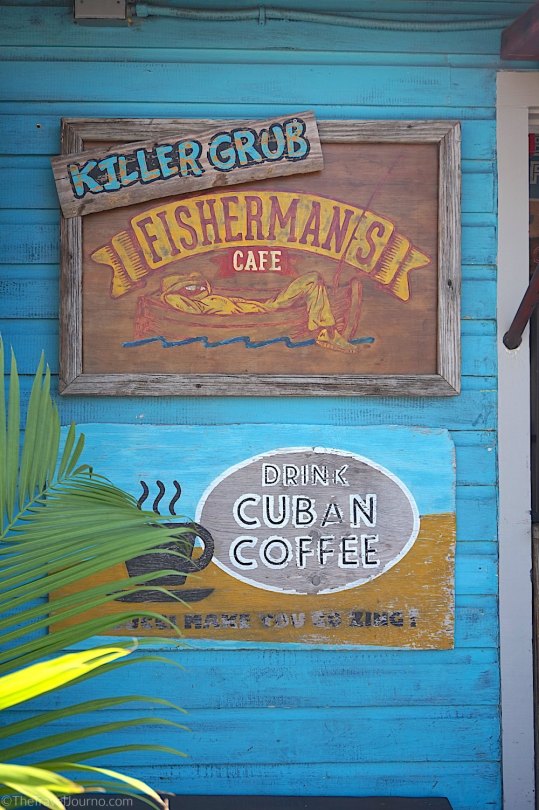
3. Puerco Asado from El Siboney
Aside from Cuban coffee, authentic Cuban food is one of the top things to eat in Key West. See if you can book a table at El Siboney, a no-frills Cuban diner which attracts both locals and tourists and has become something of an institution in Key West’s Old Town.
The menu features all sorts of chicken, seafood and beef dishes, but if you’re only visiting once, try the Puerco Asado, a Cuban classic. This slow-roasted pork is often marinated in various herbs, garlic, onions and lime. And it’s a great dish to try alongside typical Cuban staples such as Moro (rice and beans), sweet or green plantains, fried cassava and tamale (steamed corn husk).
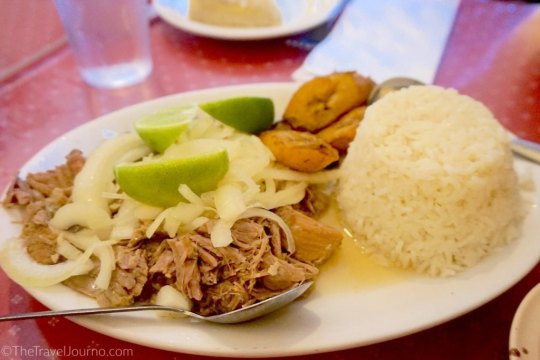
4. Empanadas & Arepas
We realised empanadas were big in Florida as soon as we got to Miami. You’ll find them dotted all around the city, especially in Little Havana. In Key West, these Latin American-style pasties are just as big, especially at breakfast time. In fact, empanadas and arepas (a corn meal dough filled with meat, cheese and other fillings) are among the most popular street food snacks in Key West.
Head to El Siboney, Bliss restaurant or Frita’s Cuban Burgers for some of the best empanadas and arepas. As the name suggests, the latter is also famous for its incredible Latin-inspired burgers.
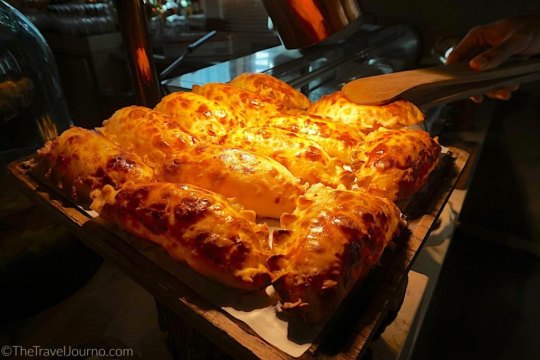

5. Burritos and Tacos from Badboy Burrito
As I mentioned in my post about the Southernmost Food Tour, the burritos and tacos from Badboy Burrito are legendary in Key West.
Try the fish tacos and you’ll be surprised at how fresh they taste – a delicious concoction of grilled fish topped with sour cream, radish, jalapenos and fragrant coriander. When we visited, ours were filled with succulent chunks of tile fish, one of the most sustainable types of fish you can eat in Key West.
Fun fact – Badboy Burrito featured on the Food Network. You’ll find a second shop further up the Keys in Islamorada too.
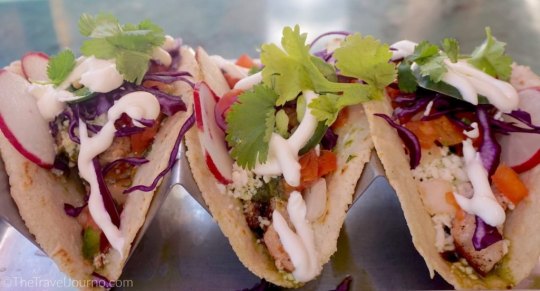
6. Quesadillas from Bistro 245
Quesadillas are another South American street food that are vying for your taste buds in Key West. And to be honest, I hadn’t paid them much attention until I tried the incredible lobster quesadillas from Bistro 245 at the Margaritaville Resort.
We visited this waterfront restaurant for dinner one evening and their stylish take on the quesadilla – enhanced with tomato, caramelised onions, manchego cheese, mango salsa, cumin sour cream and juicy chunks of lobster – was one of the best things I’ve ever tasted. Don’t miss out!

7. Key lime pie from Key West Old Town & Bahama Village
There are so many different ways to enjoy Key Lime Pie and I wouldn’t blame you if you wanted to try them all as it’s not just one of the top things to eat in Key West, it’s also one of the most famous dishes you can eat in the whole of the Keys.
You’ll see Key Lime pies presented in various different ways across the region – some are presented with a meringue top (more traditional in Key West), some without; some are topped with whipped cream and most are baked on a graham cracker base. We even discovered chocolate-coated Key Lime Pie on a stick. (I know, amazing, right).
You can guarantee that whichever version you try, they’re going to be good.
The most famous Key Lime Pie shops in Key West include Key West Key Lime Pie Co, The Key Lime Bakery and Kermit’s Key West Key Lime Shoppe.
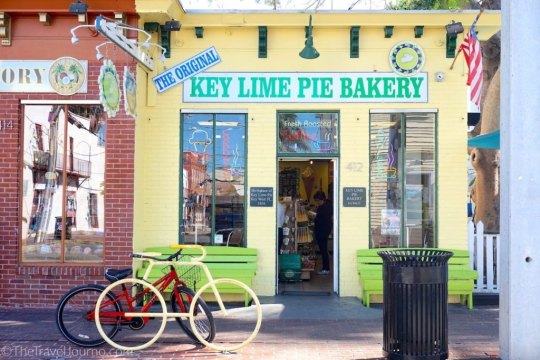
You can also try these gorgeous mini Key Lime Pies (pictured) at the legendary Blue Heaven in Bahama Village. They are out of this world.
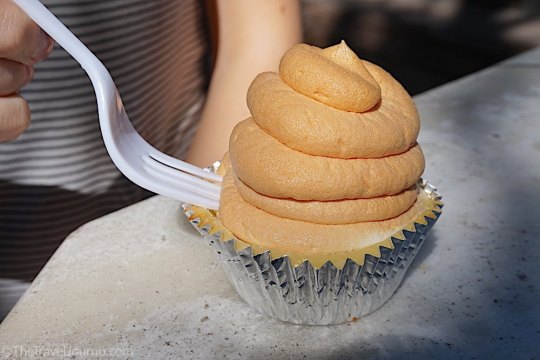
8. Other Key Lime treats
From Key Lime cookies and Key Lime jelly beans to tea, chutney and taffy, the use of this citrus ingredient doesn’t stop at pie. Floridians have become quite inventive with its use and you’ll find a whole host of Key Lime-infused treats across Key West and Florida Keys.
Put aside some time to explore the various Key Lime shops across the Old Town. We found all sorts of delicious Key Lime hot sauces which you can try before you buy. And on the none-foodie front you’ll find scrubs and toiletries infused with this tangy ingredient).

9. Conch – fritters, cracked, chowder and burgers
Key Westers (or Conchs as they nickname themselves) pride themselves on cooking with this locally-caught specialty. So whether these squidgy sea snails tempt you or not, you’ve got to try them at least once!
Ease yourself in by trying cracked conch (flash fried in tempura batter) or the conch fritter with your beer at Mangoes. Then if you like it, I can highly recommend the conch sandwich at Fishermans Café on the waterfront. It’s served on a Kaiser burger bun with lettuce, tomato and Key Lime tartare sauce and their sweet potato chips are excellent.
For the best conch salad in Key West, I hear that it’s Johnson’s Grocery, an unassuming shop in the heart of Bahama Village.
And finally, when it comes to conch chowder, try El Siboney, Willie T’s or the Conch Republic Seafood Company on the waterfront and you won’t be disappointed.
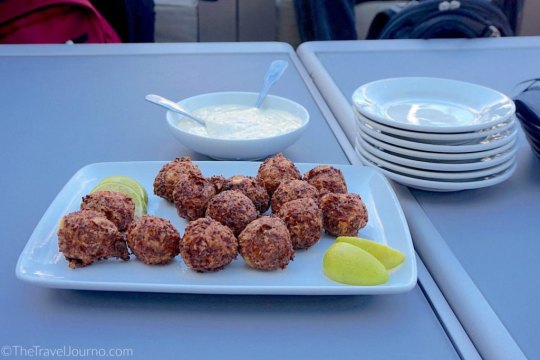
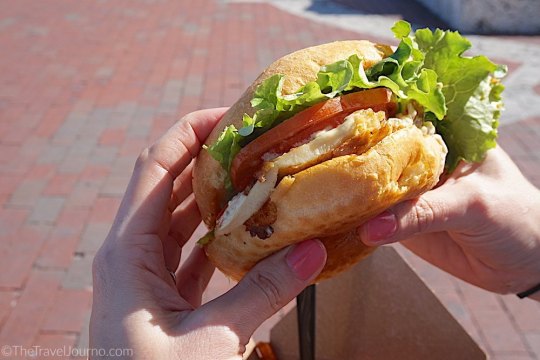
10. Hogfish sandwich from Geiger Key Marina
I don’t actually know what hogfish tastes like but I heard a lot of people talking about it while we were in Key West. And the hogfish sandwich – chunks of this white fish encased in soft Cuban bread with Swiss cheese and onions – is a favourite way to enjoy it here.
While not technically in Key West, the Hog Fish Bar on nearby Stock Island, is renowned for this Florida Keys staple. But Geiger Key Marina restaurant is probably one of the best places to try either hogfish, mahi-mahi or grouper sandwiches if you’re staying on Key West island. You’ll be asked whether you want your fish fried, grilled or ‘blackened’. If you go for the latter, the fish will be cooked in a spicy ‘blackening’ seasoning that’s used over the Keys.
Blackening seasoning made by Chef Bobby Stoky of Marker 88 restaurant
11. Rum Runner from the Speakeasy Inn & Rum Bar
When it’s time for a tipple, a rum runner is one of the top things to drink in Key West. It’s a mix of light and dark (or aged) rum, banana, blackberry, grenadine, pineapple juice, orange juice and Bacardi, lime juice or sours and was actually invented in Islamorada in the Upper Keys, as a nod to the rum runners of the prohibition era.
In Key West, you’ll get the best rum runner cocktail at The Speakeasy Inn & Rum Bar, a characterful place in the Old Town, on Duval Street. It was originally owned by Raul Vaquez of Key West’s Gato cigar factory and it stocks over 250 types of rum.
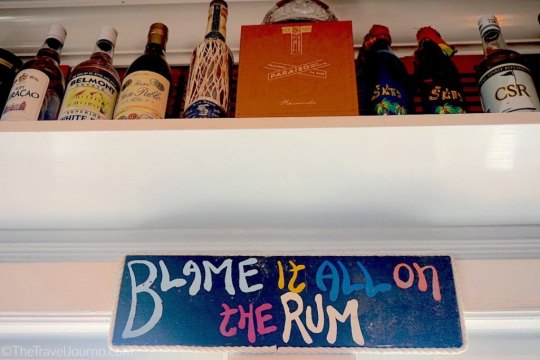
12. Caribbean inspired cooking
Thanks to its proximity to the Caribbean islands and its strong Caribbean community, the food in Key West has many West Indian influences (which made me very happy).
On our first night in Key West, we dined at Blue Macaw Island Eats where you can order Caribbean-style dishes such as jerk rum glazed chicken with plantain, ‘island-style’ salads made with fresh papaya and mango and sandwiches made with authentic Cuban bread.
Over at Blue Heaven in Bahama Village, you’ll find a bounty of Caribbean-inspired curries on the menu with jerk spices and Red Stripe Beer making their way into the chef’s cook books.
Meanwhile, for no-frills Creole food that’s cooked from the heart, check out Mo’s, a Haitian restaurant where the servings are as big as the flavours.
Find authentic home cooking that’s transports you to the Caribbean
13. Stone crab, shrimp and spiny lobster
If you like seafood, you’ll be in your element in the Florida Keys. So once you’ve tried the local conch and lobster, you might like to try a few other types of locally-caught shellfish.
Shrimp here can be served in all sorts of ways. So look out for crispy tempura batter, the famed Floridian ‘blackening’ or jerk sauce. You’ll find it’s used in all sorts of Caribbean curries too.
The Caribbean spiny lobster here is served straight up in its shell (most commonly you’ll order the lobster tail), blackened, in a curry, or used inventively in Latin-inspired dishes such as tacos and quesadillas. I actually tried both the lobster and local shrimp together in a very indulgent fettuccine at Bistro 245 and it tasted incredible.
If crab’s more your thing, Key West and the rest of the Florida Keys are known for their stone crab. Try the popular Stoned Crab restaurant on North Roosevelt Boulevard for expertly-made dishes such as stone crab bisque and their famed ‘steamers’.
And you don’t have to wait for dinner to try Key West’s best seafood. Both shrimp and lobster make their way onto many breakfast menus here. Try the famed shrimp or lobster eggs benedict at Blue Heaven in the Bahama Village.

Have I got you feeling hungry? What are your tips for the top things to eat and drink in Key West? Feel free to leave your comments.
Pin Me
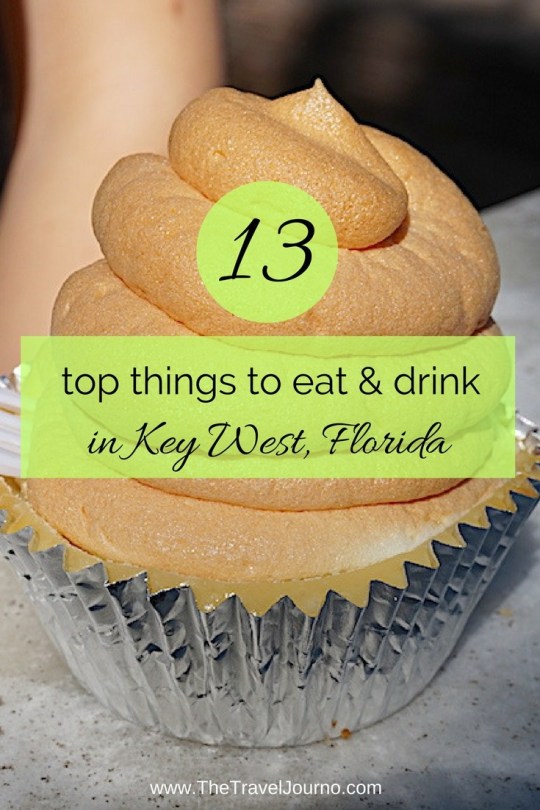
Like this:
Like Loading…
Some of my restaurant visits mentioned were hosted by The Florida Keys & Key West Tourist Board. All views here are my own.
from Cheapr Travels http://cheaprtravels.com/top-things-to-eat-and-drink-in-key-west-florida/ via http://cheaprtravels.com
2 notes
·
View notes
Photo


Seashells in Oil - 20″ x 16″, ~ 14 hours. my final painting for the semester! shells are lightning whelk, snail’s eye, crown conch, scallop, and baby horse conch.
1 note
·
View note
Text
🌊🐚Shells and other Beach Correspondences🐚🌊
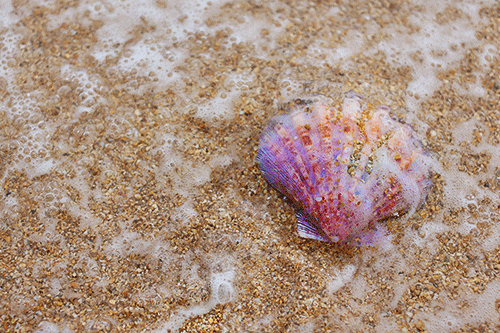
💙🐚What are Shells?🐚💙
Shells are the outer protective coatings of certain marine invertebrates such as mollusks. They are mainly combosed of calcium carbonate and chitin. Shells are formed along with the invertebrate and as the creature grows, the shell grows as well because of the added calcium layers. When the creature dies, the innerds are either eaten or rot away leaving clean remnents behind. Sea shells are extremely important to the marine ecosystem and are more than just pretty things to look at.
For one they serve as homes to many invertebrates and crusteceans like hermit crabs. The majority of sea shells found along beaches are the remnents of deceased invertebrates. But even the remnents have their uses! Shells are used as food sources for microbes, worms, and other creatures. They are also used by coral branches, sea weed, and sponges to "anchor" onto and start growing. You can even find a layer of algae or barnacles growing on the surface. Some animals such as sea urchins and small fish also use them as protection. Even certain species of sea birds use sea shells in their nests! The layer of sand and limetone on the ocean floor is mainly made up of eroded shells and rock as well. 🔹Source🔹
💙🐚Shell Correspondences🐚💙
In general all shells can be used for protection, beauty, love, and friendship spells. Broken shells can be grounded into powders to be used in jars, powder recipes, and more. Shells can also be used in curses by breaking them and imagining the shell as your target. They represent the element of water and the goddesses Venus and Aphrodite. Since they are formed in the ocean and are exposed to moonlight they also correspondend to lunar energies. Shells can also be worn as amulets.
🐚Abolone: These large shells have a perlescent patterns on their insides. They can be used as offering bowls or to smother smoke bundles. Because of their beautiful patterns they can be used for finding hidden treasures and wealth.
🐚Amonite: Theyse are ancient creatures that are related to the nautalus. The correspondences between the two are very similar. The amonites brain-like shape make them excellent for memory spells. Amonites have existed since possibly before the dinosaurs and correspond to deep wisdom. Also, amonites are know to have crystals inside them, making their properties even better. Amonites are very easy to find at museum shops, zoo stores, online, etc. They are extinct so you don't have to worry about buying them unsustainably. Nautalus on the other hand, are a different story. Do not buy nautalus shells since they are criticaly endangered and the mass harvesting of their shells is driving them to the brink of extinction.
🐚Auger: The augers phallic shape makes it good for spells pertaining to masculinity.
🐚Clam: Because of their accoation to the goddesses Venus and Aphrodite, clam shells are very good in love, friendship, beauty, and relationship spells.
🐚Cockle: Ever heard the phrase "warming the cockles of someone's heart"? That's what gives the cockle shell it's meaning! Cockles are good for love, friendship, and relationship spells because of the relation to the cockles (ventricles) of the human heart.
🐚Conch: They are known to make a horn-like sound when blown into, making them good for communication spells. I also like to put them near the entrance of my room/home for protection and to keep out bad energy. They are also good for love and friendship spells.
🐚Cone: They are generally good for protection and curses. The cone snail is a venomous, predatory snail with a special "harpoon" meant to inject venom into prey animals and predators. The venom of the larger cone snails can be fatal to humans (especially the Australian ones).
🐚Cowry: Were used as a currency in some civilizations and are associated with wealth. They also represent feminine energies, fertility, and menstruation due to the shape of the opening being similar to female genitalia.
🐚Moon: Their beautiful moon-like shape makes them perfect for lunar and emotional magic. They can also be used for dream work, meditation, and divination.
🐚Murex: Because of their many spines they are very good for protection spells.
🐚Olive: Since olive oil is good for healing and skin care, I also like to use this seashell for healing spells.
🐚Oyster: Are known to create pearls and are considered a delicacy among many costal cities. Because of this, oysters are good for wealth, success, and good fortune spells.
🐚Scallop: They are actually very speedy mollusks and move around a lot. Because of this they can be used in movement and travel spells. White scallops are like the clear quartz of shells and can be used to amplify spells or to substitute for other shells.
🐚Whelk: Because of the easy to handle shape of the shell, welks correspond to control and positive change.
💙🐚Shell Care🐚💙

🐚🔷Cleaning🔷🐚
Sometimes shells collected from the beach have a funky smell to them. This is due to bacteria and algae beginning to rot and it produces a foul smell. To clean them you can either..
Scrub them with baking soda and water (be gentle!)
Place them in soil for a few weeks. The good bacteria along with bugs in the soil will begin to eat the dead stuff.
Boil them. Make sure you place them in when the water is lukewarm so they don't break due to the heat.
Make sure you do NOT clean them with vinegar. Shells are composed of calcium and vinegar wears down calcium. 🔹Source🔹
🐚🔷Charging🔷🐚
Shells collected directly from the sea don't really need this step and are good to go. However, shells that were bought or have been collecting dust in your closet need an energy reset. Take your shells and place them in saltwater (along with some sand, charged shells, or seaweed if you like!) and let them charge for a few hours. If you want a real boost, let them charge under moonlight.
💙🐚Shell DIY's🐚💙
Besides using shells as spell ingredients, you can also use them to make...
Shell candles
Mermaid crown
Incense burners
Offering bowls
Spoons
Wall hangings
Wind chimes
Runes
💙🐚Other Beach Treasurers🐚💙
🔹Crab claws: The zodiac Cancer is represented by the crab. Using crab claws and shells in spells can help you get more intuned with Cancer (if that's your zodiac). They are also good for protection, curses, and emotion magick.
🔹Driftwood: Corresponds to strength, endurance, and "going with the flow" because of how it floats across the sea and is shaped by relentless waves.
🔹Hag Stones: They are formed when erosion or creatures create holes in rock. The constant erosion and saltwater make hag stones smooth and rounded. They are referenced in pop culture including the movies Coraline and the Spiderwhick Cronicles. If you've seen either of these movies, you will know that hag stones were used to help the main character see hidden things/creatures. This is why they are good for clarity spells. They can also be used for protection amulets to either hang around the house or on yourself.
🔹Sand dollar: I like to associate sand dollars with wealth because of the name. They also are a natural pentacle shape and can be used on your altar, as an amulet, or in protection spells.
🔹Sea glass: Is formed when glass is broken up and eroded by salt water. Over time the glass edges become blunt and the glass is given a lovely texture and color. Sea glass is a lot of time used for clarity spells because of their glass components. I also like to use them in meditation, dream work, and physchic spells. They can also be used for change, "going with the flow", and endurance because of how they were formed.
🔹Sharks teeth: Sharks teeth have many uses. They can be used in protection spells. I also associate them with success or "grabbing your desires" because of how sharks grab their prey. Teeth can be used in curses as well.
💙🐚Shell Collecting PSA🐚💙
‼️If you need shells, either get them from the beach, buy them from an antique or second hand store, or buy them from someone who responsibly collects them. DO NOT buy them from those souvenir shops or craft stores. Shells, dried sea horses and star fish, and other creatures are mass harvested from the ocean every year, dead or alive. They are left out in the sun to dry out and are then sold across the world in shops or as crafting supplies. This mass harvesting is depleting ocean at an alarming rate and is causing ecosystems to collapse. 🔹Source🔹
‼️If youre collecting shells, only take what you need. Are you really going to use ALL the shells you collected in that bucket? Shells are very important to the ocean since they are the home to many different animals such as crusteceans. Leave pleanty of shells behind for the little guys. 🔹Source🔹
18 notes
·
View notes
Text
What Do Snails Eat?
"Snails feed on a variety of food found in their natural habitat. What they consume depends on where they live & the species of snail that they are. Some conventional foods are plants, fruits, vegetables, & algae. Plants that are dying are often a good meal for them, & they also eat sand or soil when seeking for calcium to get a thicker shell.
Snail diet
Most terrestrial snails are herbivorous, but others are omnivorous & some even carnivorous. Each species has different eating habits, depending on their size, age, habitat, & individual nutritional requirements...
The herbivorous snails devour a wide variety of live plant parts: leaves, stems, plant crops, bark, & fruits. Many consume fungi & mushrooms, & others may occasionally add algae, although these are an important food for freshwater snails.
Some snail species enjoy plants that are already dead, as well as animals or any dead organic matter...
Carnivorous snails eat several types of small animals; this is the case of the species of the genus Powelliphanta, which live in New Zealand & feed on other gastropod mollusks such as slugs & earthworms, among other terrestrial animals.
On the other hand, omnivores can include plants & animals into their diet, but usually, these animals prefer other terrestrial animals, so they are practically predators. For example, the species Rumina decollata can eat other species of conch, slugs, annelids like worms &, to a lesser extent, plants.
Snails have to feed on foods that include significant amounts of calcium to keep their shell hard. When looking for food they use their powerful sense of smell.
They are nocturnal so that they look for food during the night or the very early morning hours. They consume more food than usual if the winter approaches so they can store up fat reserves to live on while they hibernate.
When food sources are very low in the summer or spring months, they may voluntarily put their body into a state of estivation as well. This process allows them to survive in severe conditions of drought.
A singular mouth
The mouth of terrestrial snails is unknown to most people... These mollusks have an organ in the mouth with rows of tiny teeth, sometimes compared with a tongue, fully functional at the time of eating.
The radula is this structure inside the snail’s mouth that has rows of chitin teeth. When the food reaches this structure that looks like a sac, the teeth do not cut or grind it like human teeth would. Instead of being chewed, the radula scrapes the food & breaks it, before it passes through the esophagus to continue the digestion process.
These tiny teeth suffer much wear & tear as time passes. Therefore, they are continually replaced by others. Not all species have the same number of teeth. Some have rows with a few, but in others the number reaches hundreds.
Snails are often said to be very noisy eaters. However, the sounds you hear aren’t them consuming the food. It is the radula tearing & scraping the food.
A problematic diet?
...Certain terrestrial species, such as the Giant African Snail (Achatina fulica), are a headache for farmers & owners of crops since they have no scruples about consuming economically valuable plant species such as cacao, cucumber, papaya, Bean, squash, cauliflower & some cereals, just to name a few. This species, considered in many countries an invasive animal, generates important economic losses..."
From https://www.snail-world.com/what-do-snails-eat/
0 notes
Text
Everything You Need to Know About Costa Rican Food

A dish from manos en la masa in San José, Costa Rica | Courtesy of Hulu
Abundant farmland, seas, and jungles, plus a stunning mix of cultural influences, have made Costa Rica a Latin American food destination
Costa Rica is one of the few countries on earth where someone can spend an entire week and leave without having any real sense of the local cuisine. The closest many travelers ever get is trying zapote and guanábana at the hotel breakfast bar, secluded inside a resort town, surrounded by expats. What they miss out on is one of Latin America’s most underappreciated cuisines.
This is a country where anything and everything grows. You can walk down the busiest streets in San José and pick pitaya and wild tomatoes right from the sidewalk. Beyond the cattle ranches and coffee plantations, small farmers grow vegetables like chayote, arracacha, and purple corn that are often sold through the country’s vast network of ferías, the weekly regional farmers markets held in every corner of the country. There are minty drinks from mucilaginous, chia-like seeds of a plant called chan, and syrups made from the carob-like pods of a tree called carao. There are addictive bar snacks made from beans and chicharrón, plus seafood from two coasts. Corn is ubiquitous, used to make tortillas, tamales, and cookies.
Costa Rica was one of the first countries to allow American travelers during the COVID-19 pandemic, and restaurants remain open at reduced capacity. While the safety of international travel is still not clear, for future trips, plan to step outside of the expat bubble, away from the multinational hotel chains and toward any small-town restaurant or market — you’ll see the world of Costa Rican cuisine begin to open up. Here, then, is a comprehensive guide to navigating all the ins and outs of eating in Costa Rica.

Courtesy of Hulu
An indigenous woman from the Amburi Koswak tribe plates a traditional Costa Rican spread
Understanding the Influences
“We are a beautiful mix of cultures,” says chef Pablo Bonilla, whose restaurants Sikwa and Francisca reinterpret Indigenous and pre-1950s recipes, respectively. “From Spain came the Catalans, Andalusians, Galicians. Africans came from Guinea, Ghana, and later via Jamaica. Plus, Indigenous descendants of the Mayas in the north and Chibchas in the south.”
Prior to colonization by the Spanish, Costa Rica fell in between the more dominant cultural groups from the north and south, and the country’s present-day Indigenous communities reflect this overlap. In Guanacaste and the Nicoya peninsula, communities of Chorotega, the southernmost descendants of the Maya, still grow and process corn much in the same way they have for thousands of years. Many of their traditional foods, such as tortillas and pancake-like chorreadas, were adapted by the wider population, while the use of porridges and drinks made from maíz pujagua, or purple corn, are more isolated. In the mountainous Talamanca region in the south, communities of Bribri and Boruca people live off the land, safeguarding many ancestral ingredients, while also growing cacao for wider consumption.
Like in the rest of the region, colonization swept across the land like a hurricane, wiping out much of Costa Rica’s native foodways while introducing European livestock and agriculture. The Spanish cut down forests to raise cattle and pigs and planted wheat and rice. Many national recipes, such as olla de carne and countless sweets, are of Spanish origins, having been adapted to involve regional ingredients.
While some Afro-Costa Ricans are descended from enslaved Africans who were forcibly brought to the region during the colonial period, a far greater number are descendants of the English-speaking Jamaican migrants who came in the 19th century and settled on the Caribbean coast. Here, coconut milk is a staple ingredient, used in seafood stews like rondon or to cook rice and beans, as are root vegetables like cassava and yams.
While it hasn’t always been for the best, the United States has also left its mark on Costa Rican cuisine. A surge of Americans have migrated to the country in recent decades, more than 70,000 by some estimates, and many have gone on to open restaurants and start small culinary projects, with mixed success. However, American influence has a much lengthier history tied to monocultures (banana, pineapples, coffee), which have had drastic effects on the country’s food system as well as the environment.

Shutterstock
A classic casado de res served on banana leaf
The Dishes to Know
Gallo pinto (rice and beans)
Claimed by both Costa Rica and Nicaragua, gallo pinto is the regional variation of rice and beans, which is usually seasoned with bell peppers, cilantro, and onions. The name, which translates to “spotted rooster,” refers to the spots of beans that stand out against the white rice, though sometimes it’s just referred to more casually as pinto. For breakfast, it might be served with a fried egg, while for lunch and dinner it’s a side to meat or fish.
There are subtle regional variations. For instance, black beans are the norm, though in Guanacaste, on the Pacific coast closer to Nicaragua, red beans are more typical. The condiment Salsa Lizano, a light brown sauce similar to Worcestershire that’s found on most Costa Rican tables, is stirred into the pot in San José and around the Valle Central. On the Caribbean coast, it might be cooked with coconut milk and chiles.
Chifrijo (fried pork with red beans}
Nearly every cantina in Costa Rica serves this bar snack, which is believed to have been first prepared in the late ’70s at the still-functioning Cordero’s Bar in the town of Tibás outside San José. Its name is the combination of its two signature ingredients: fried pork (chicharrón) and beans (frijoles). It’s sometimes served with a base of rice or toppings like avocados and tomatoes, but the original preparation is eaten more like a bowl of nachos, with tortilla chips and chilera (spicy pickled vegetables) on the side.
Rondón (seafood and coconut stew)
Whatever fish and vegetables a cook has “run down” to by the end of the week get thrown in a pot with coconut milk, herbs, and spices for this typical dish of Costa Rica’s Caribbean coast. The thick stew is found in many parts of the Caribbean and was brought to Central America by Jamaican laborers in the latter half of the 19th century. In Afro-Costa Rican communities like Cahuita or Puerto Limón, rondón might include red snapper, clams, mussels, conch, or sea snails, plus green plantains, cassava, and chiles with a side of coconut rice and breadfruit.
Casado (combo plate)
Translating to “married man,” the casado is Costa Rica’s typical lunch plate. There’s no set recipe, but rather a general mix of simply prepared vegetables with a protein. It might be grilled fish, stewed beef, a pork chop, or fried chicken served with white rice, beans, and coleslaw or some sort of salad of iceberg lettuce and tomatoes. Everyone makes it a little differently, though: They might add fried plantains, slices of avocado, tortillas, or a fried egg, depending on the region and the season.
Olla de carne (beef and vegetable stew)
Olla de carne is eaten every weekend in many Costa Rican homes, often for family gatherings as the long cooking time and amount of vegetables added make it difficult to make in small portions. Beef, usually short ribs and various off cuts, is simmered for four to eight hours with a handful of vegetables that may include yuca, potatoes, chayote, carrots, corn, or plantains. It’s then served with rice and beans on the side, of course.

Getty Images / Sergio Amiti
A bowl of seafood ceviche
Picadillos (vegetable hash)
There’s no truer reflection of Costa Rica’s agricultural bounty than these homey hashes, simple mixes of chopped vegetables sauteed in fat with onions, stock, herbs and other seasonings. The name of the dish always states the primary vegetable being used, such as picadillo de zapallo (squash), vainitas (green beans), chayote, arracache (arracacha), papa (potato), and even fruits like papaya. It’s served over white rice, sometimes with a protein like ground beef or chorizo, or on corn tortillas to make gallos — Costa Rica’s version of the taco — a picadillo becomes a full meal.
Chorreadas (corn pancakes)
These sweet or savory pancakes, made from ground, fresh white or yellow corn, are a staple in Costa Rican kitchens and sodas (small, simple, often family-run establishments) for breakfast. The most typical versions, where the corn is ground by hand, can be traced to pre-Columbian times, though today it’s more likely to be blended in a food processor and thickened with flour and eggs. When sweet (and they are rarely overly sweet), they might be drizzled with honey or syrup. When savory, a dollop of sour cream-like natilla is usually served on top.
Ceviche
Unlike its Peruvian counterpart, Costa Rican ceviche features fish that’s typically marinated in lime juice for at least an hour in the fridge, rather than just seconds, resulting in a more opaque, less raw-tasting fish. It’s usually made with peeled shrimp or firm white fish like sea bass, though sometimes you’ll find chuchecas (blood clams) and a mixture of finely chopped or minced onions, tomatoes, garlic, and cilantro. And many locals swear by a splash of ketchup or tabasco.
Tamales
In the days before Christmas, a favorite pastime is the tamaleada, when families get together to make the star of Christmas dinner: pork tamales. Costa Rican tamales have been adapted from their Indigenous origins to include introduced ingredients like rice, chicken, beef, and carrots. They are never steamed in a corn husk; rather, they are always made in a banana leaf, and when two of them are tied together, as they are often sold, it’s called a piña.
Beef turnovers (patí)
In snack bars and sodas in Caribbean towns like Puerto Limón and Cahuita, the patí is ever-present. Similar to a Jamaican beef patty, but spiced with the local chile panameño, or ají chombo, it is a means of survival for many Afro-Costa Rican women who once sold them on trains and busy streets from wicker baskets, and continue the tradition from Tupperware containers.
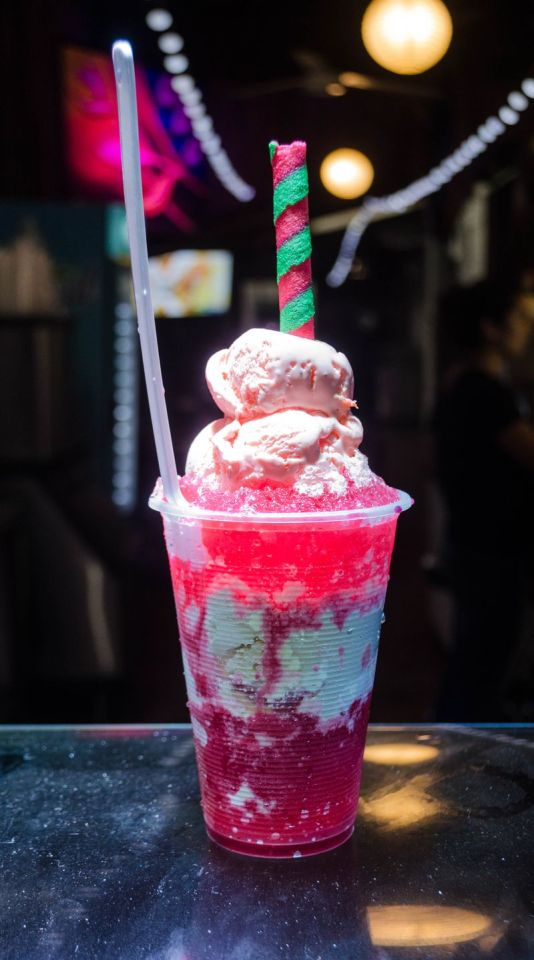
Shutterstock
The Churchill, made with red kola syrup and condensed milk, is Costa Rica’s signature copo.
Peach palm soup (sopa de pejibaye)
Pejibaye, a starchy orange palm fruit, has been widely planted across Costa Rica even prior to colonization. The fruit needs to be boiled for at least an hour to be edible, and then, once peeled and pitted, it can be pureed into a soup with stock, cream, and seasoning.
Shaved ice (copo)
On plazas and beaches throughout Costa Rica, kiosks and roving carts specialize in a local variety of shaved ice called copos or granizados. The cups or cones are topped with everything from milk powder and flavored syrups to fresh fruit and marshmallows. The most emblematic variation is the Churchill, which was named after a man in Puntarenas who looked remarkably like Winston Churchill and always ordered his copo with bright red kola syrup and condensed milk.
Sweetened squash paste (miel de chiverre)
Costa Rica has the typical pan-Latin sweets like flan, tres leches cake, and arroz con leche, but more endemic is this chunky, sweet paste made from chiverre, the fig leaf gourd. This large squash has a sweet, spaghetti-like flesh that gets dried and then cooked with panela, cinnamon, and other spices. The locals’ favorite way to eat it is as the filling of a sweet empanada, though it’s also used to make candy or just eaten with a spoon.
What to Drink
Coffee probably comes to mind when one thinks of drinking in Costa Rica, and there’s a good reason for that. While coffee growing was focused mostly on quantity for more than a century, recent decades have seen a shift toward greater traceability and micro-lots, resulting in more distinct coffees that can be found in new-wave coffee cafes and roasters in San José and the occasional beach town.
In rural and Indigenous parts of the country, you can still find ancient, sweetened drinks like pinolillo and tiste, made from cornmeal or rice and cacao, as well as agua de sapo, a refreshing concoction made from ginger, panela, and lime. There are also chichas, low-proof drinks made from fermented corn or fruits like pejibaye.
In terms of alcohol, the national firewater is the sugarcane-based guaro, which is sometimes mixed with tomato juice, lime juice, and hot sauce for the shot-sized chiliguaro. The general population leans toward mass-market lagers like Imperial and Pilsen, though a growing number of craft breweries around the country, like Treintaycinco, Cervecería Calle Cimarrona, Costa Rica’s Craft Brewing Co., and Domingo 7, are making inroads. Meanwhile, experimental bartenders are breaking new ground by featuring local botanicals and fermented drinks on the drink lists at area hot spots like Bebedero from celebrity bartender Liz Furlong, the clubby Selvática, and hotel bars Celajes and Sentido Norte.
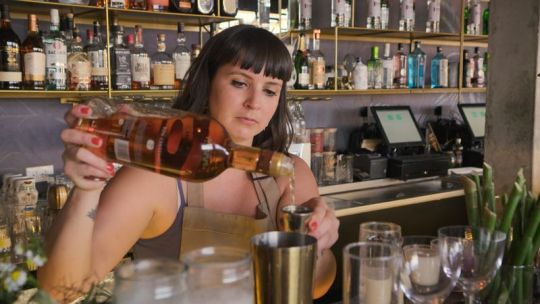
Courtesy of Hulu
Bartender Liz Furlong crafting a drink at Selvática
When to Eat
With foods like rice, beans, and tortillas often eaten at breakfast, lunch, and dinner, meals in Costa Rica can seem repetitive. Breakfast tends to be heavy, with gallo pinto sometimes joined by eggs and fried plantains, while lunch and dinner will swap out the eggs for simple proteins and add a few vegetables. In the afternoon, especially on the weekends, a cup of coffee and a baked good like an empanada or cookie may be added.
During the week, most meals are taken at home, including midday lunch, when many businesses shut down, and might be followed by a siesta. Those on the go might stop by a soda, which are usually open from breakfast until the afternoon, while other restaurants tend to close their kitchens by 10 p.m., if not earlier. For weekend lunches, family gatherings become full-day affairs with tamales and slow-cooked stews like olla de carne, while rural and beach restaurants are at their busiest.
Where to Eat
While gringo-run restaurants with standard international menus full of imported ingredients rule many resort towns, they aren’t where most Ticos opt to eat. Fresh, seasonal produce and locally raised and caught meats and seafood can often be found along the side of the highway. Outside of formal restaurants, there are some other spots for a good meal:
Sodas
Outside of someone’s home, sodas are the place to eat traditional Costa Rican food. These unpretentious, independent restaurants range from simple lunch counters in urban markets to sprawling, family-run restaurants in the countryside. The menus will have a mix of regional favorites, plus low-cost set meals like casados.
Marisquerías
Marisquerías are similar to sodas, but they specialize in seafood. They are mostly found along the coasts, though not necessarily right on the beach. They’ll offer simple dishes like camarónes al ajillo (garlic shrimp), arroz con mariscos (rice with mixed seafood), grilled or fried fish, soups, and ceviches.
Ferias del agricultor
On Fridays, Saturdays, or Sundays, every region of Costa Rica holds its weekly feria, a farmer’s market positioned around seasonal fruits and vegetables. There’s often live music and vendors selling ready-to-eat foods like pipas (young coconuts), sliced fruits, gallos, and empanadas.
Roadside fruit stands
On highways and country roads throughout Costa Rica, open-air fruit stands are an easy pit stop. Aside from the mangoes and bananas, keep an eye out for lesser-known fruits like manzana de agua (water apples), guanábana (soursop), carambola (star fruit), mamón Chino (rambutan), mamey, and marañon (cashew fruit).

Courtesy of Hulu
Pablo Bonilla of Sikwa
What’s Next
The restaurant revolution that swept up much of South America and eventually Central American neighbors like Panama and Guatemala arrived late to Costa Rica but is now in full swing, at least around the capital.
After years working in France, chef José González returned home and opened Al Mercat in 2014, and he began exploring the country’s biodiversity through foraged and fermented ingredients. During the pandemic, he moved the restaurant from its original Barrio Escalante to his parent’s ranch on the outskirts of San José. At Sikwa, Pablo Bonilla has been working with Indigenous communities like the Boruca and Bribrí to resurrect ancestral dishes, while Silvestre, set in a beautifully restored 1930s Barrio Amón house, is serving contemporary Costa Rican food through its elaborate tasting menus.
Former Jamie Oliver right-hand man Sebastián La Rocca, who was born in Argentina, has built a mini empire in Escazu with his wood-fired Costa Rican cooking at Botaniko, speakeasy izakaya Rōkka, and ghost kitchens slinging gourmet burgers and choripan. Additionally, at Descarada Tradición, Sofía Campos and Luis Chaves are reviving the tradition of the gallo with housemade tortillas, while at MadFish, Tere Moreno is helping raise the profile of the artisan fishing community of Puntarenas.
This renewed culinary scene is still in its early days, though it’s gradually spreading toward the jungles and beaches, where pop-ups, surf cafes, and creative street-food vendors are showing signs they’re more interested in working with the country’s natural bounty than trying to appeal to the unsustainable demands of tourists.
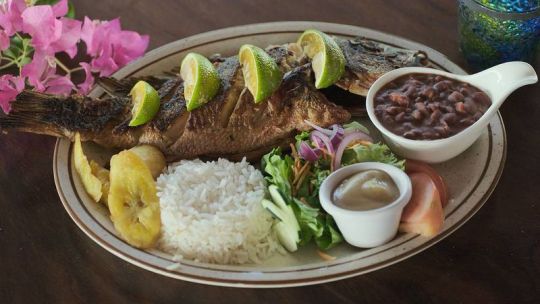
Courtesy of Hulu
A whole fish with plantains, rice, and beans
Writer and photographer Nicholas Gill is the co-founder of New Worlder.

from Eater - All https://ift.tt/3kugYnD https://ift.tt/2It7ifs

A dish from manos en la masa in San José, Costa Rica | Courtesy of Hulu
Abundant farmland, seas, and jungles, plus a stunning mix of cultural influences, have made Costa Rica a Latin American food destination
Costa Rica is one of the few countries on earth where someone can spend an entire week and leave without having any real sense of the local cuisine. The closest many travelers ever get is trying zapote and guanábana at the hotel breakfast bar, secluded inside a resort town, surrounded by expats. What they miss out on is one of Latin America’s most underappreciated cuisines.
This is a country where anything and everything grows. You can walk down the busiest streets in San José and pick pitaya and wild tomatoes right from the sidewalk. Beyond the cattle ranches and coffee plantations, small farmers grow vegetables like chayote, arracacha, and purple corn that are often sold through the country’s vast network of ferías, the weekly regional farmers markets held in every corner of the country. There are minty drinks from mucilaginous, chia-like seeds of a plant called chan, and syrups made from the carob-like pods of a tree called carao. There are addictive bar snacks made from beans and chicharrón, plus seafood from two coasts. Corn is ubiquitous, used to make tortillas, tamales, and cookies.
Costa Rica was one of the first countries to allow American travelers during the COVID-19 pandemic, and restaurants remain open at reduced capacity. While the safety of international travel is still not clear, for future trips, plan to step outside of the expat bubble, away from the multinational hotel chains and toward any small-town restaurant or market — you’ll see the world of Costa Rican cuisine begin to open up. Here, then, is a comprehensive guide to navigating all the ins and outs of eating in Costa Rica.

Courtesy of Hulu
An indigenous woman from the Amburi Koswak tribe plates a traditional Costa Rican spread
Understanding the Influences
“We are a beautiful mix of cultures,” says chef Pablo Bonilla, whose restaurants Sikwa and Francisca reinterpret Indigenous and pre-1950s recipes, respectively. “From Spain came the Catalans, Andalusians, Galicians. Africans came from Guinea, Ghana, and later via Jamaica. Plus, Indigenous descendants of the Mayas in the north and Chibchas in the south.”
Prior to colonization by the Spanish, Costa Rica fell in between the more dominant cultural groups from the north and south, and the country’s present-day Indigenous communities reflect this overlap. In Guanacaste and the Nicoya peninsula, communities of Chorotega, the southernmost descendants of the Maya, still grow and process corn much in the same way they have for thousands of years. Many of their traditional foods, such as tortillas and pancake-like chorreadas, were adapted by the wider population, while the use of porridges and drinks made from maíz pujagua, or purple corn, are more isolated. In the mountainous Talamanca region in the south, communities of Bribri and Boruca people live off the land, safeguarding many ancestral ingredients, while also growing cacao for wider consumption.
Like in the rest of the region, colonization swept across the land like a hurricane, wiping out much of Costa Rica’s native foodways while introducing European livestock and agriculture. The Spanish cut down forests to raise cattle and pigs and planted wheat and rice. Many national recipes, such as olla de carne and countless sweets, are of Spanish origins, having been adapted to involve regional ingredients.
While some Afro-Costa Ricans are descended from enslaved Africans who were forcibly brought to the region during the colonial period, a far greater number are descendants of the English-speaking Jamaican migrants who came in the 19th century and settled on the Caribbean coast. Here, coconut milk is a staple ingredient, used in seafood stews like rondon or to cook rice and beans, as are root vegetables like cassava and yams.
While it hasn’t always been for the best, the United States has also left its mark on Costa Rican cuisine. A surge of Americans have migrated to the country in recent decades, more than 70,000 by some estimates, and many have gone on to open restaurants and start small culinary projects, with mixed success. However, American influence has a much lengthier history tied to monocultures (banana, pineapples, coffee), which have had drastic effects on the country’s food system as well as the environment.

Shutterstock
A classic casado de res served on banana leaf
The Dishes to Know
Gallo pinto (rice and beans)
Claimed by both Costa Rica and Nicaragua, gallo pinto is the regional variation of rice and beans, which is usually seasoned with bell peppers, cilantro, and onions. The name, which translates to “spotted rooster,” refers to the spots of beans that stand out against the white rice, though sometimes it’s just referred to more casually as pinto. For breakfast, it might be served with a fried egg, while for lunch and dinner it’s a side to meat or fish.
There are subtle regional variations. For instance, black beans are the norm, though in Guanacaste, on the Pacific coast closer to Nicaragua, red beans are more typical. The condiment Salsa Lizano, a light brown sauce similar to Worcestershire that’s found on most Costa Rican tables, is stirred into the pot in San José and around the Valle Central. On the Caribbean coast, it might be cooked with coconut milk and chiles.
Chifrijo (fried pork with red beans}
Nearly every cantina in Costa Rica serves this bar snack, which is believed to have been first prepared in the late ’70s at the still-functioning Cordero’s Bar in the town of Tibás outside San José. Its name is the combination of its two signature ingredients: fried pork (chicharrón) and beans (frijoles). It’s sometimes served with a base of rice or toppings like avocados and tomatoes, but the original preparation is eaten more like a bowl of nachos, with tortilla chips and chilera (spicy pickled vegetables) on the side.
Rondón (seafood and coconut stew)
Whatever fish and vegetables a cook has “run down” to by the end of the week get thrown in a pot with coconut milk, herbs, and spices for this typical dish of Costa Rica’s Caribbean coast. The thick stew is found in many parts of the Caribbean and was brought to Central America by Jamaican laborers in the latter half of the 19th century. In Afro-Costa Rican communities like Cahuita or Puerto Limón, rondón might include red snapper, clams, mussels, conch, or sea snails, plus green plantains, cassava, and chiles with a side of coconut rice and breadfruit.
Casado (combo plate)
Translating to “married man,” the casado is Costa Rica’s typical lunch plate. There’s no set recipe, but rather a general mix of simply prepared vegetables with a protein. It might be grilled fish, stewed beef, a pork chop, or fried chicken served with white rice, beans, and coleslaw or some sort of salad of iceberg lettuce and tomatoes. Everyone makes it a little differently, though: They might add fried plantains, slices of avocado, tortillas, or a fried egg, depending on the region and the season.
Olla de carne (beef and vegetable stew)
Olla de carne is eaten every weekend in many Costa Rican homes, often for family gatherings as the long cooking time and amount of vegetables added make it difficult to make in small portions. Beef, usually short ribs and various off cuts, is simmered for four to eight hours with a handful of vegetables that may include yuca, potatoes, chayote, carrots, corn, or plantains. It’s then served with rice and beans on the side, of course.

Getty Images / Sergio Amiti
A bowl of seafood ceviche
Picadillos (vegetable hash)
There’s no truer reflection of Costa Rica’s agricultural bounty than these homey hashes, simple mixes of chopped vegetables sauteed in fat with onions, stock, herbs and other seasonings. The name of the dish always states the primary vegetable being used, such as picadillo de zapallo (squash), vainitas (green beans), chayote, arracache (arracacha), papa (potato), and even fruits like papaya. It’s served over white rice, sometimes with a protein like ground beef or chorizo, or on corn tortillas to make gallos — Costa Rica’s version of the taco — a picadillo becomes a full meal.
Chorreadas (corn pancakes)
These sweet or savory pancakes, made from ground, fresh white or yellow corn, are a staple in Costa Rican kitchens and sodas (small, simple, often family-run establishments) for breakfast. The most typical versions, where the corn is ground by hand, can be traced to pre-Columbian times, though today it’s more likely to be blended in a food processor and thickened with flour and eggs. When sweet (and they are rarely overly sweet), they might be drizzled with honey or syrup. When savory, a dollop of sour cream-like natilla is usually served on top.
Ceviche
Unlike its Peruvian counterpart, Costa Rican ceviche features fish that’s typically marinated in lime juice for at least an hour in the fridge, rather than just seconds, resulting in a more opaque, less raw-tasting fish. It’s usually made with peeled shrimp or firm white fish like sea bass, though sometimes you’ll find chuchecas (blood clams) and a mixture of finely chopped or minced onions, tomatoes, garlic, and cilantro. And many locals swear by a splash of ketchup or tabasco.
Tamales
In the days before Christmas, a favorite pastime is the tamaleada, when families get together to make the star of Christmas dinner: pork tamales. Costa Rican tamales have been adapted from their Indigenous origins to include introduced ingredients like rice, chicken, beef, and carrots. They are never steamed in a corn husk; rather, they are always made in a banana leaf, and when two of them are tied together, as they are often sold, it’s called a piña.
Beef turnovers (patí)
In snack bars and sodas in Caribbean towns like Puerto Limón and Cahuita, the patí is ever-present. Similar to a Jamaican beef patty, but spiced with the local chile panameño, or ají chombo, it is a means of survival for many Afro-Costa Rican women who once sold them on trains and busy streets from wicker baskets, and continue the tradition from Tupperware containers.

Shutterstock
The Churchill, made with red kola syrup and condensed milk, is Costa Rica’s signature copo.
Peach palm soup (sopa de pejibaye)
Pejibaye, a starchy orange palm fruit, has been widely planted across Costa Rica even prior to colonization. The fruit needs to be boiled for at least an hour to be edible, and then, once peeled and pitted, it can be pureed into a soup with stock, cream, and seasoning.
Shaved ice (copo)
On plazas and beaches throughout Costa Rica, kiosks and roving carts specialize in a local variety of shaved ice called copos or granizados. The cups or cones are topped with everything from milk powder and flavored syrups to fresh fruit and marshmallows. The most emblematic variation is the Churchill, which was named after a man in Puntarenas who looked remarkably like Winston Churchill and always ordered his copo with bright red kola syrup and condensed milk.
Sweetened squash paste (miel de chiverre)
Costa Rica has the typical pan-Latin sweets like flan, tres leches cake, and arroz con leche, but more endemic is this chunky, sweet paste made from chiverre, the fig leaf gourd. This large squash has a sweet, spaghetti-like flesh that gets dried and then cooked with panela, cinnamon, and other spices. The locals’ favorite way to eat it is as the filling of a sweet empanada, though it’s also used to make candy or just eaten with a spoon.
What to Drink
Coffee probably comes to mind when one thinks of drinking in Costa Rica, and there’s a good reason for that. While coffee growing was focused mostly on quantity for more than a century, recent decades have seen a shift toward greater traceability and micro-lots, resulting in more distinct coffees that can be found in new-wave coffee cafes and roasters in San José and the occasional beach town.
In rural and Indigenous parts of the country, you can still find ancient, sweetened drinks like pinolillo and tiste, made from cornmeal or rice and cacao, as well as agua de sapo, a refreshing concoction made from ginger, panela, and lime. There are also chichas, low-proof drinks made from fermented corn or fruits like pejibaye.
In terms of alcohol, the national firewater is the sugarcane-based guaro, which is sometimes mixed with tomato juice, lime juice, and hot sauce for the shot-sized chiliguaro. The general population leans toward mass-market lagers like Imperial and Pilsen, though a growing number of craft breweries around the country, like Treintaycinco, Cervecería Calle Cimarrona, Costa Rica’s Craft Brewing Co., and Domingo 7, are making inroads. Meanwhile, experimental bartenders are breaking new ground by featuring local botanicals and fermented drinks on the drink lists at area hot spots like Bebedero from celebrity bartender Liz Furlong, the clubby Selvática, and hotel bars Celajes and Sentido Norte.

Courtesy of Hulu
Bartender Liz Furlong crafting a drink at Selvática
When to Eat
With foods like rice, beans, and tortillas often eaten at breakfast, lunch, and dinner, meals in Costa Rica can seem repetitive. Breakfast tends to be heavy, with gallo pinto sometimes joined by eggs and fried plantains, while lunch and dinner will swap out the eggs for simple proteins and add a few vegetables. In the afternoon, especially on the weekends, a cup of coffee and a baked good like an empanada or cookie may be added.
During the week, most meals are taken at home, including midday lunch, when many businesses shut down, and might be followed by a siesta. Those on the go might stop by a soda, which are usually open from breakfast until the afternoon, while other restaurants tend to close their kitchens by 10 p.m., if not earlier. For weekend lunches, family gatherings become full-day affairs with tamales and slow-cooked stews like olla de carne, while rural and beach restaurants are at their busiest.
Where to Eat
While gringo-run restaurants with standard international menus full of imported ingredients rule many resort towns, they aren’t where most Ticos opt to eat. Fresh, seasonal produce and locally raised and caught meats and seafood can often be found along the side of the highway. Outside of formal restaurants, there are some other spots for a good meal:
Sodas
Outside of someone’s home, sodas are the place to eat traditional Costa Rican food. These unpretentious, independent restaurants range from simple lunch counters in urban markets to sprawling, family-run restaurants in the countryside. The menus will have a mix of regional favorites, plus low-cost set meals like casados.
Marisquerías
Marisquerías are similar to sodas, but they specialize in seafood. They are mostly found along the coasts, though not necessarily right on the beach. They’ll offer simple dishes like camarónes al ajillo (garlic shrimp), arroz con mariscos (rice with mixed seafood), grilled or fried fish, soups, and ceviches.
Ferias del agricultor
On Fridays, Saturdays, or Sundays, every region of Costa Rica holds its weekly feria, a farmer’s market positioned around seasonal fruits and vegetables. There’s often live music and vendors selling ready-to-eat foods like pipas (young coconuts), sliced fruits, gallos, and empanadas.
Roadside fruit stands
On highways and country roads throughout Costa Rica, open-air fruit stands are an easy pit stop. Aside from the mangoes and bananas, keep an eye out for lesser-known fruits like manzana de agua (water apples), guanábana (soursop), carambola (star fruit), mamón Chino (rambutan), mamey, and marañon (cashew fruit).

Courtesy of Hulu
Pablo Bonilla of Sikwa
What’s Next
The restaurant revolution that swept up much of South America and eventually Central American neighbors like Panama and Guatemala arrived late to Costa Rica but is now in full swing, at least around the capital.
After years working in France, chef José González returned home and opened Al Mercat in 2014, and he began exploring the country’s biodiversity through foraged and fermented ingredients. During the pandemic, he moved the restaurant from its original Barrio Escalante to his parent’s ranch on the outskirts of San José. At Sikwa, Pablo Bonilla has been working with Indigenous communities like the Boruca and Bribrí to resurrect ancestral dishes, while Silvestre, set in a beautifully restored 1930s Barrio Amón house, is serving contemporary Costa Rican food through its elaborate tasting menus.
Former Jamie Oliver right-hand man Sebastián La Rocca, who was born in Argentina, has built a mini empire in Escazu with his wood-fired Costa Rican cooking at Botaniko, speakeasy izakaya Rōkka, and ghost kitchens slinging gourmet burgers and choripan. Additionally, at Descarada Tradición, Sofía Campos and Luis Chaves are reviving the tradition of the gallo with housemade tortillas, while at MadFish, Tere Moreno is helping raise the profile of the artisan fishing community of Puntarenas.
This renewed culinary scene is still in its early days, though it’s gradually spreading toward the jungles and beaches, where pop-ups, surf cafes, and creative street-food vendors are showing signs they’re more interested in working with the country’s natural bounty than trying to appeal to the unsustainable demands of tourists.

Courtesy of Hulu
A whole fish with plantains, rice, and beans
Writer and photographer Nicholas Gill is the co-founder of New Worlder.

from Eater - All https://ift.tt/3kugYnD via Blogger https://ift.tt/38yBVv9
0 notes
Text
The Drunk Elf who did a Thing™
A short story that was suggested and that I should have shared long ago
It was supposed to be a simple job. Hired to get in, do her work, and leave. Go unnoticed, disguised amongst the crowd, and if anyone did see her, well, it could just mean a little extra work in the future. After all, the most important thing in life was getting paid, only second to getting paid a lot. But the latter was harder to obtain, so she had to settle with whatever job she could find, which lead to her current situation.
She wasn’t sure how long a bard could hold her breath that many miles deep in the ocean
It all had begun the previous evening, sitting in the middle of the town center, watching people pass by as she earned her daily copper by playing any requested tune in her trusty old lute. It was fun, it was relaxing, and the fact there were more visitors in the small town than usual meant a much better meal at her inn than what she had been getting the whole week. She wasn’t sure why that many people were hanging out there, and she didn’t really care either, as she planned to leave during the weekend for the next town in the map.
Just when she thought there should be enough money for a stew, she heard it. Music as she had never listened before, sounds that she would have otherwise never even considered possible, a melody that captivated her and everyone around her. Standing from her seat, and quickly climbing over the statue she had been sitting next to the whole day, she spotted the parade not too far away, emerging from the forest and with a clear path to the docks. People clapped, sung and laughed to the rhythm, just as she was tempted to join them, raising her instrument and doing her best to copy the music as the ensemble approached, the crowd surrounding her moving aside to let them pass. Only when they were close enough did she see who they were: a curious mix of merpeople and land inhabitants, some carrying instruments she was familiar with, most holding items clearly sea themed, the source of the sounds she couldn’t identify.
And the group kept moving forward, closer and closer to the beach, and yet they didn’t seem to be getting any further away from her. Only when her feet touched the cold water did she realize that she had followed along the procession, accompanying the music with her own instrument until whatever enchantment the notes had broke and she realized what she had been doing. The sound was starting to fade, as she stared at the people vanishing under the water, when she felt a tap on her shoulder.
“What’s wrong? Aren’t you going to follow the rest of the band?... Ah, I see, they didn’t finish casting the water breathing spell on you. Gods, I hope you are the only one, this is going to be very, very bad publicity for us if a corpse ends up floating to the shore in the morning... Hmm, the sigil should go like this... and... There we go. Come on, you are going to lose them in the seaweed jungles.”
Before she even had the chance to notice who or what had talked to her, still in the midst of her daze, the figure jumped into the water after shoving something into her hands. Blinking back into reality, she looked down to see... Pearls. Pearls as big as her eyes, round, perfect and shining against the moonlight. More money in a single round sphere than what she could make in a whole year travelling and playing her music.
The next thing she knew, she was running into the water, then swimming, then diving until she saw again the end of the parade, the promise of more riches in her mind as she resumed playing tirelessly through the dark depths, guided only by the sound coming from in front of her.
Caethia wasn’t just the capital of the Cohrian Kingdom, it was the kingdom itself. Every citizen of the kingdom owned a house in Caethia, and from the farthest reaches of the sea they would go for the Equinox celebrations. Why or how they celebrated this means little to this story, though. The only important detail is that artists from the surface would also be invited, returning with treasures from the depths to their own homes and the memories of the gathering.
It was early morning when she arrived. The city built in coral reefs, close enough to the surface to receive the sun rays, yet deep enough to not be subjected to the constant movement of the waves or passing ships. The light from above dimmed as they went deeper and deeper, but others would replace it, through magical means allowing the visitors to explore and go around the strange landscape, whilst the natives would prepare for the evening festivity. She visited every stall and open house, did her best to talk with the merpeople who didn’t know Common, tried new dishes and clothes to amuse herself, and danced, and danced, and danced until the sun sunk into the horizon. Not like she or anyone else there could see that, but the city turning darker was a sure sign of night approaching.
But as the rest of visitors and locals were getting ready, she... was a little lost. It was easy to take the wrong turn, specially considering she was alone and new to the place, and some parts would look the same no matter in which direction she swam. Was she upside down? It was hard to tell, and in hindsight, spending so much time with that nice couple and their ridiculously good snail ale could have only worsened her current situation. Because it was good, and they had so much of it they didn’t mind parting with a few bottles, most of which she had discarded as she kept swimming.
But she was far too drunk to notice the trail behind her, so her only option was to continue going down (or up?) and further along the only path she could see, until she could no longer hear the music coming from the party. Past doors and crevices she went, somehow managing to get behind several guards without them seeing her, or her even seeing them.
And then she saw it. The biggest pearl in the world (or so her dazed mind thought), gently floating above an important looking pedestal, eyeing her reflection on it as she pondered how much she could get for it. No, she wasn’t a thief, she was but a humble musician, but anyone could dream about a better future. She could sell the ones she already got for a lot of gold, but the one in front of her... maybe she could finally replace her lute’s strings. Or better yet, she could get it plated in metal. Silver would look nice with the fancy clothes she wanted to buy as well. She could even get a house. Or a castle. With servants, and great meals every day, and she would never have to work a day in her life.
And then she touched the pearl, and it fell from its stand.
Above, in Caethia’s plaza, the music ended. The visitors had no idea what was happening, while the merpeople looked around, frightened, as the reefs lost their color, turning white before they began to crumble, small pieces first, and giant chunks of coral began falling from above just as the ground too cracked under everyone. The merpeople fled by the hundreds and then thousands from their homes, in the midst of the confusion and rage knocking aside everything in their path, searching for the source of the city’s decay, but it was too late. A long, drawn out note came from a guard’s conch in the last pillar standing, the only sign to evacuate before it also toppled onto the city. In less than an hour, and before the even celebrations began, Caethia had fallen.
She woke up with a start in the middle of the room, the last thing she remembered being a sharp pain in the back of her head before everything faded out. It took her a moment to realize she was underwater, another to calm down until she realized she was able to breathe, and yet even more time to recall the events of the previous night. She dug into her pockets to find them empty, and looking around, no sign either of the giant pearl she had knocked over before. There was no music or laughter or dancing either, and as she left the room, no life either, wandering the empty hallways for what felt like hours until she finally made it to the main streets. Or what was left of them, the coral buildings stacked on top of each other, blocking the path upwards, no matter where she went all she could see was the whiteness of the dead structures. What even had happened? She felt uneasy, a feeling in her gut telling her that somehow, just maybe, this was all her fault. But there was no one to ask, nowhere to go, and nothing to do.
She tried to not cry as she picked up her lute and began playing, the last melody ever sung in the empty Caethia. Until the spell ended, and her lungs gave up, and her fingers stopped moving.
A lonely fisherman stood on his boat, looking at the still body he had just fished out of the sea. As he was about to offer the elf his prayers, a loud cough stopped him mid sentence, hacking and spitting seawater into his boat, causing the old man to laugh as he helped the elf up and offered a skin of fresh water.
“They sure know how to party, huh?”
1 note
·
View note
Text

Now the clean up crew: 10 dwarf blue leg hermit, 5 red tip leg dwarf hermits, a scarlet hermit, fighting conch, a serpent star fish, coral banded shrimp, sally light foot crab, 30 assorted snails. Because the shipment was delayed a day due to weather in the middle of the country, drip acclimation was done very slowly over a period of 3 hours. Food was also, given durning acclimation too.
0 notes
Text
Ingesting our way close to Vital West, Florida
A person of my favorite methods to understand a vacation spot is by simply just having the community delicacies. I mean who doesn’t get pleasure from having a gastronomic tour the place you get to stroll, speak, consume and drink your way via an area’s best places to eat, bars and culinary institutions?
Critical West Meals Excursions are one of the best-acknowledged food tour groups in the Florida Keys. They supply three principal food stuff and drink excursions all-around Critical West. But their Southernmost Food items Tour is the greatest excursion you can do if you want to consume like a regional and get a full knowledge of the island’s food stuff lifestyle.
In fifty percent an hour of arriving into Key West, we have been at Siboney Restaurant in which we ended up completely ready to meet our Important West foods tour information, Analise Smith.
Analise has Cuban heritage in her relatives so she was effectively qualified to teach us on the Cuban foodstuff scene in Essential West.
The Southernmost Meals Tour: Feeding on our way close to Critical West, Florida
El Siboney, Key West
El Siboney is a single of the most renowned Cuban dining places right here and has come to be anything of an establishment considering that it opened in 1984. You will discover El Siboney in the Old City and it is an unassuming purple brick developing, nonetheless continuously attracts in the crowds for its authentic Cuban cooking.
So, if you want to take in right here, critically contemplate reserving in advance.
The Southernmost Food Tour lasts three hours, but there is a whole lot of taking in to do. So Analise doesn’t mess about.
When our food stuff was becoming well prepared, she gave us a crash-class in how to drink Cuban espresso and the numerous approaches you can purchase it.
There’s the Cafecito or Café Cubano (served in a thimble-sized cup), a Café con leche (espresso with steamed milk), a Cortadito (served with a very small splash of steamed milk) or the Bucci (a strong shot of espresso that’s served with cane sugar.)
If there is additional than a single of you, you can go with the tradition of purchasing a Colada which is in essence an additional-large cup of the sweet Bucci, which you then share among a number of folks in the thimble-sized cups (see image underneath.)
Yet another Cuban tradition is also to order the ridiculously additional-ish pan Cubano (Cuban bread) and dunk it in your drink. Delish.
Cubans have a very sweet tooth, or as Analise claims, they are ‘sweet freaks’. So introducing sugar to the espresso is a given. If they talk to you whether or not you’d sugar, they’re really asking if you’d like even more sugar than what they instantly set in.
So you could be bouncing off the walls following tasting this. You have been warned!
The foods dish we try at El Siboney is the vintage roast pork, or Cuban Puerco Asadoas it’s recognised. If you read through my overview of Versailles in Miami, you will know that BC tried out a dish like this there. However, I have to say, this a single was tastier. It was served with white rice, fried plantain and a squeeze of contemporary lime, with a incredibly hot sauce on the facet. Delicious.
It was time to go on.
Badboy Burrito
Badboy Burrito, our up coming quit, is a hole-in-the-wall restaurant and bar. It’s below you’ll choose up what are arguably, the most effective tacos and ‘build-your-own’ burritos in Critical West. The extended queue claims it all.
It is a no-frills variety of position, so you pull up a chair outdoors, get a chilled consume and prepare to get your fingers messy. The Southernmost Foods Tour very encouraged we tried the fish taco. And for superior explanation. They’re designed utilizing ‘tile fish’, which are a single of the most sustainable fish you can consume in the Florida Keys.
Numerous persons are still unaware of this additional ‘environmentally friendly’ alternative of fish. And when I’d say it’s not bursting with flavour, it was surely livened up by the salsa verde, sour cream and cilantro. The govt chef at Badboy Burrito is really passionate about using the freshest components. So considerably so, they don’t even have freezers. You can warranty on ocean-to-plate top quality and you cannot beat the name both.
A bit of history and lifestyle
In in between all the having, Crucial West Food items Tours will make positive they fill you in on the a lot of cultural and historic spots of fascination you go on the way. On the Southernmost Meals Tour, Analise regaled us with all kinds of tales about Key West’s cigar-building record, the ‘shotgun houses’ in which factory employees lived, as well as the stories at the rear of the quite a few quirky retailers and properties you’ll obtain on the island, these types of as the Tomasita Seafood store.
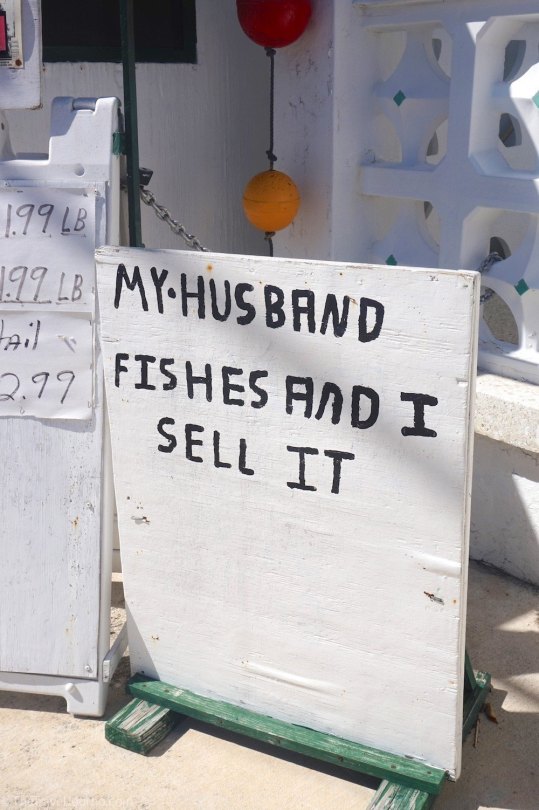
Many thanks to its proximity to the Caribbean, Vital West was a big player in rum importation, even during America’s prohibition period.
And just after all our strolling, Analise determined it was time for a tipple – which takes us on to one of the island’s most well-known speakeasies, The Rum Bar.
The Rum Bar
I’m a huge admirer of rum, so it was a little disappointing that I was unable to make the most of this little bit, staying six months pregnant! But whether you’re consuming alcohol or not, The Rum Bar is an intriguing place to check out. You are sure to meet up with a quirky character or two.
You’ll find The Rum Bar on Essential West’s famous Duval Road and it was at first owned by a gentleman referred to as Raul Vaquez, who was a cigar selector at the island’s famed Gato cigar manufacturing facility.
They stock an impressive 250+ sorts of rum, which you can of training course sample straight, or in one of their a lot of basic cocktails.
Seemingly Vaquez’s true enthusiasm was functioning as a ‘rum runner’ concerning Important West and the Caribbean. The sector turned so in-need, they established a ‘rum row’ – a three-mile route concerning Crucial West and Bermuda the place ‘rum runners’ travelled back again and forth.
So it only appeared correct that on the Southernmost Meals Tour, the team attempted the synonymous Rum Runner cocktail – a combine of white and dark rum, banana, blackberry, grenadine, OJ, pineapple and sours. Meanwhile, Analise kindly requested me a Rum Runner sans alcohol.

Livened up and all set to go, our next prevent on the Key West Food stuff Tour was the Bahama Village, one of my favourite regions of Key West and where by the majority of Crucial West’s Caribbean community settled.
Analise crammed us in on the background of the colourful clapboard houses and stopped by important points of desire such as the significantly-loved Rick Value mural….
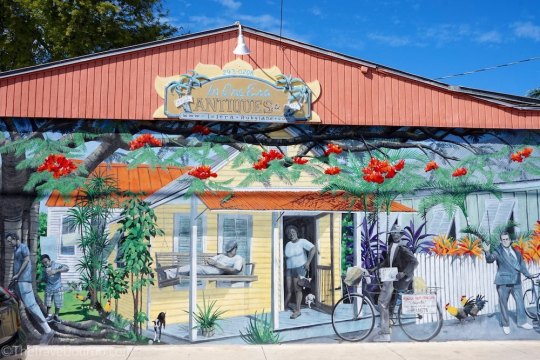
…and the family members property of famous trumpeter Theodore “Fats” Navarro.

But our future halt on the Southernmost Food items Tour was one more Crucial West institution, Blue Heaven.
Blue Heaven
If you are ever in Critical West, this is in all probability the restaurant I’d propose as a great all-rounder. Positioned in just a leafy yard, comprehensive with roaming roosters and a rooster cemetery (they like their roosters below), an out of doors bar and quirky knick-knacks, it is packed with that Bohemian appeal you will come across in several components of Crucial West…
…and they serve a Critical Lime Pie which is to die for.
As you are going to study on this gastronomic journey, Key Lime Pie is a typical Important West dessert and there are all sorts of variants in how it’s served.
In this article at Blue Heaven, we tried using it in miniature form, comprising of a delicious biscuit foundation and a tangy lime filling topped with a pillow-delicate meringue.
They were so tooth-achingly sweet, these cute minimal miniatures ended up far more than plenty of. If you are eager to attempt the many variants of this neighborhood treat, head to the several Vital Lime Pie stores and factories in the Outdated City and sample them all!
We headed again to Blue Heaven for a good brunch a couple of days later and I’d remarkably advocate a visit.
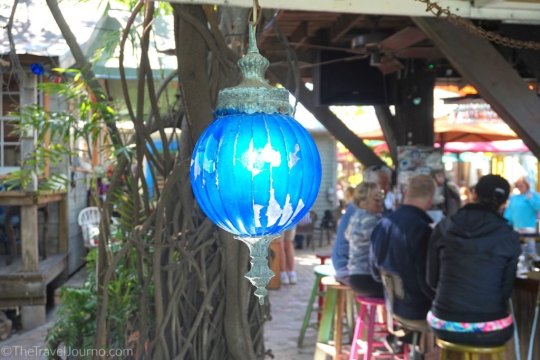
Mangoes
Mangoes is extra of a mainstream bar and cafe you will discover on Duval Road. But its indoor-outdoor really feel and good cocktail bar vibe absolutely make it worthy of viewing. As we discovered on the food tour, it’s also a fantastic place to sample a different culinary staple, conch.
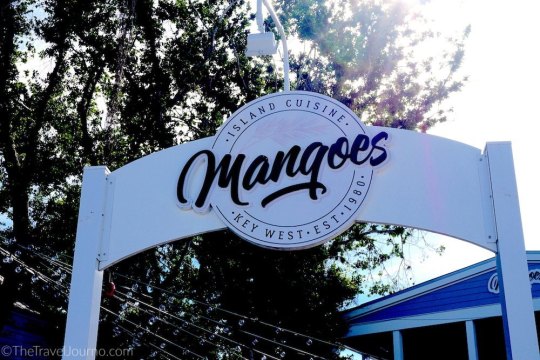
Conch is the sea snail you will find in abundance in Critical West. It’s also what lots of individuals however nickname them selves below soon after the tongue-in-cheek motion in 1982 which saw Crucial Westers form a micronation dubbed the ‘Conch Republic’.
These squidgy molluscs are usually utilised to make ceviche and chowder but you are going to also find them shallow-fried, or deep fried to make fritters. At Mangoes, they have been served as fritters with a mouth watering aioli created utilizing the community Important Lime.
They’re fantastic as a tasty snack and style even greater when enjoyed in the sunshine, with a refreshing beer.
Aspect note: Component foods child, portion genuine infant escalating in my tummy listed here..

Important West Distilling
Our final stop on the Southernmost Food items Tour was Critical West Distilling, a compact distillery on Southard Avenue that generates craft spirits, rums, vodkas, gin and whiskey.
Yet again, I experienced to scent somewhat than flavor, but Analise provided an attention-grabbing introduction into their exceptional distilling processes, the means they develop the oak flavours and the a variety of substances and spices that are made use of below.
If you’re brave sufficient, you will consider the overproof rum which has a mighty 76.5% alcohol content. Or probably you’ll sample the horseradish vodka?



Either way, it was a fantastic close to a superb tour with Important West Food stuff Tours.
I’m so happy we did the Southernmost Food items Tour as shortly as we arrived into Important West. It presented a wonderful introduction to the island, it taught us a ton about the Florida Keys society and we left with a prolonged checklist of recommendations on places to eat and consume, which is never a bad point.
The Southernmost Foods Tasting & Cultural Strolling Tour charges from $75 for grown ups and $49 for kids aged 12 and under. You can locate out a lot more about Vital West Food items Excursions on Facebook, instagram, twitter and via their web site.
Find out much more about the Florida Keys and Crucial West by using the Florida Keys and Essential West Vacationer Board.
Pin Me
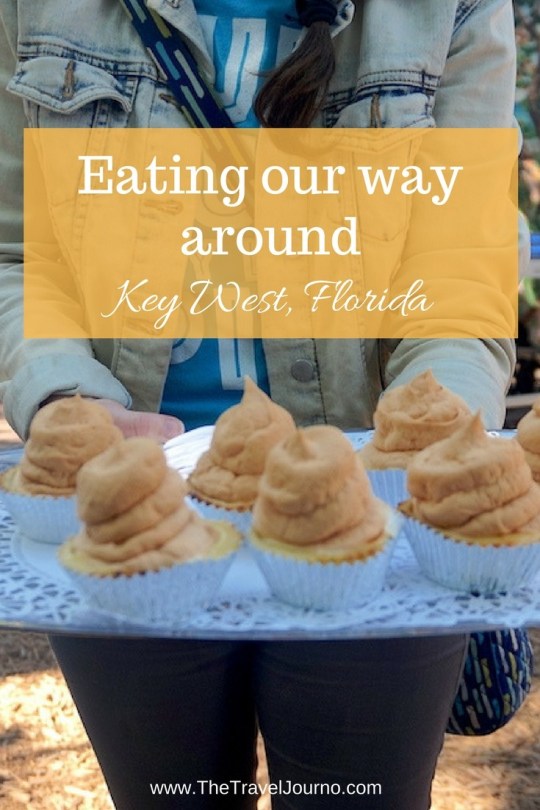
Like this:
Like Loading…
My ticket for the Southernmost Food Tour was organised by the Florida Keys Vacationer Board
from Cheapr Travels http://cheaprtravels.com/ingesting-our-way-close-to-vital-west-florida/ via IFTTT
0 notes
Text
SEA SHELLS, THEIR MEANINGS AND MAGICK
SeastarsMermaidsCove MENU AND WIDGETS Day 21~ Sea Shells, their Meanings and Magick
Long before fancy new-age tools became readily available through specialty shops, our magic-using ancestors turned to nature for their power objects. Natural objects are imbued with spiritual energies that we can harness for our own use in spells and charms. Seashells in particular have a long history of magical uses, as they were associated with the powers of various sea gods and goddesses of different cultures.

Being born of the ocean, shells are strongly associated with the element of water. They are also associated with the moon, which drives ocean tides. Both the element of water and the moon have strong feminine energies that are receptive in nature, so shells are primarily used in magic to draw things you desire into your life.
Shells taken from the ocean need little ritual preparation for magical uses; however, if your shells were bought from a store or have been stashed in a box for a while, they may benefit from cleansing and recharging. To do this, place your shells in a bowl of water mixed with sea salt. Set them aside to soak for a day or overnight. Recharge them by setting the bowl in the sun or under the light of the full moon for several hours.
Love
One of the main symbols for Aphrodite, the Greek goddess of love, is the seashell. Invoke the power of Aphrodite for love spells using shells by wearing seashell jewelry or hair ornaments to attract a mate. Use a hinged seashell with the two parts still attached as a powerful love talisman to keep two lovers together. Write the initials of the lovers on the inside of the shell, one on each side, then seal it shut with glue.
Prosperity
Many cultures used shells as a form of currency. Cowrie shells were used in Africa and North America, and Native Americans used wampum—beads made from clam shells—as money. Because of this, shells are suitable for money spells. Fill a small green or gold pouch with seashells, a silver coin and mint, which is a money-drawing herb. Hang the bag where you do business, and rub it when you desire prosperity. Place a small seashell in your wallet or purse to continually keep money coming to it.
Protection
Protection is a shell’s primary purpose in nature, as it is made to keep small, defenseless sea creatures safe from harm. Because of this, shells have strong protective energies. Many cultures in coastal areas use shells in folk magic to protect the home by placing strings of shells over windows and doors. Necklaces of strung shells can be worn by children to keep them close to home and safe from harm. Placing a small, round shell on the collars of your pets will keep them safe should they wander from home.
Seashells that wash up on the shore come from a netherworld where ocean meets land. Because of the Moon’s influence on the tides, these seashells hold the energy of the Moon goddess. Many shells, particularly sea snails and the chambered nautilus, form or contain a spiral—the powerful symbol of the Great Mother Goddess. Spiral shells can be used to stimulate energy in your home or in ritual. Other shells have a calming effect because of their smooth surfaces. Shells can be placed anywhere singly, or they may be in jars, bowls, and baskets. A summer wreath for the front door could include a few seashells to add their magic to the energy that enters your home.

“Shells are gentle healers and messengers, and very powerful tools of transformation. Each seashell was created as its home by an individual animal who had their own package of DNA and their own consciousness. Each shell, therefore, has its own bundle of information to share with us. That information is waiting to be accessed whenever we hold a particular shell, or even just look at one in a photograph.” Tracy Holmes Shells and their Meanings
Sea Shells can be used as a magical component for any spell. Naturally, each type of shell has its own particular associated which lend itself more to some spells than others.
Abalone:
Abalone Shells have a strong elemental bond with the Earth and it’s healing capabilities. Abalone is closely connected to that of the Water element and the vibrations of Love, Beauty, Gentleness, Caring, Compassion and Peace.
Abalone Shell has been used in jewelry making and religious spiritual ceremonies for countless ages. It is also known as “the Sea Ears” because of it’s flattened, oval shape with iridescent interior. It was used by Native Northwest American Indians for cleansing, offerings and prayers. Usually Abalone is found off the coasts of South America, Japan and China.
On an intuitive level, Abalone helps to stimulate psychic development and intuition while promoting the power of imagination. It has a soothing vibration that can help calm emotions during deep healing and will emotionally support the growth of Self.
Physically, Abalone can heal the body within the Chakras but resonates most with the Third Eye, Heart and Solar Plexus Chakras. Within Third Eye Chakra, it will stimulate psychic intuition. Within the Heart Chakra it will help to gently clear and release emotions of fear, sorrow or any other negative feelings held. Within the Solar Plexus, it will use the power of Nature to re-instill the Power of Self.
Abalone can be used for chakra balancing because abalone has all of the colors of the rainbow, abalone can be used with almost any chakra balancing techniques you have learned.
Abalone will help with anxiety and stress related issues in high strung individuals. It will also help with relief with arthritis, joint disorders, muscular problems, the heart and the digestive system. It is very helpful for athletes that would like to help build and protect healthy muscle tissue while strengthening the heart muscles!
I use mine as a Smudge pot!!
Lined the bottom with a bit of tin foil to protect the shell from being scorched and made cleaning it much easier!!
Abalones power to protect from negativity helps protect your magick spells and rituals. Incense burned in an abalone shell incense holder is empowered for any kind of magick.
You can also use to contain empowered herbs, and stones.
The Abalone is useful for finding things hidden and good fortune. It is also a good shell for meditating upon inner beauty and strengthening self love.
 Common Atlantic Auger shells Auger: Frequently found on local beaches, lovely shades of purples and periwinkle blue.
This is a large family of very long and slender shells, ranging in size and with numerous whorls. Due to it’s phallic shape it may be used for any male oriented magic, e.g. fertility, courage, power and in the aid to healing male ailments.
 Knobby Cerithium Shells Ceriths-also plentiful on Gulf beaches
Most species of this major family are also small, long and thin. Due to its phallic shape it may be used for any male oriented magic, as well.
 Sandro Botticelli, The Birth of Venus (c. 1486) Clam (Many families of Clams, Tridacna, Mactra, Solenidae, Cultellidae, Veneridae)
The giant clams are a small but well known family of large to very large shells. The Goddess Venus is often depicted standing in a Clam (the Tridacna Gigas). This shell is perfect for Goddess related spells and rituals. It is also ideal for love and friendship spells.
Used for purification and love. A small clam shell may be etched with a rune and made into a potent talisman.
Cockle: The basis of the expression “warming the cockles of the heart,” this shell is best used in spells for love, friendship, relationships, emotions.
This is a large and very well known family, composed chiefly of edible bivalves, which live in worldwide locations in both shallow and deep water. This shell is suitable for spells of love, friendship, family and emotions and we are reminded of it with the saying “to warm the cockles of my heart”.
THESE are plentiful in January and February here!! I use them as dishes for everything!!
 Queen Conch Conch: When blown, this shell produces a loud noise. It can be used effectively in spells of summoning, for difficulties in communicating, and as an aid in clearing up misconceptions.
The conch shell was one of Buddhism’s eight auspicious symbols, signifying truthful speech and strength. It also appears in the Hindu tradition of prayer, and was the weapon of choice of mystical mermaids and mermen, looking up to the magnitude of waves across the ocean. As such, its mystical meaning alludes to strength and fortitude.
The Queen Conch is the epitome of the femaleness of the sea!! She stands in for the Goddess on my altar alongside the Horse Conch for the God.
 Horagai The conch, or shankh, is the most ancient musical instrument known to man.
Horagai are large conch shells that have been used as trumpets in Japan for many centuries. They are used for religious purposes or as a signal for samurai.
Obtained as a gift from the great ocean, it was held as sacred, and reference is found all over ancient Indian literature. It is seen in the hands of almost all gods and goddesses, whenever they were happy or going off to war. In Buddhism the conch shell’s call is meant to awaken one from ignorance, and is a sign of victory over suffering. In Chinese Buddhism, the conch shell signifies a prosperous journey, and in Islam it represents hearing the divine world.
The spiral formation inside the conch is symbolic of infinity. The space , which gradually expands in a clock-wise direction. The shell is like the human journey of life. The hard casing protects life. The pearl inside (a scallop or oyster), and its aquatic nature associates it with the feminine, lunar, and virginity that is symbolic in music. The conch shell’s spiral form and relation to water cause it to represent the beginning of existence.
 Horse Conch Horse Conch, Florida’s official state shell since 1969. This large conch is called a ‘horse’ for a good reason. The Horse has long held deep and rich symbol meanings which would apply to the Horse Conch.
Power Grace Beauty Nobility Strength Freedom Forward Movement  Fighting Conch The Fighting Conch has a richly deserved reputation. A small, scrappy shell it is very aggressive in its defense. If you find one of these the Message is to ‘stand your ground’ and even ‘put up your dukes’. Sometimes we have to defend what we believe in, what matters the most, what our principles stand for.
 Crown Conch Crown Conch is a small royal purple shell with a ‘crown’ of protruding spines. Reminds us to remember our own Royal Divinity, as Daughters and Sons of the Sea Goddess.
Cones– May suggest it is time to “take charge” of a situation you have been hoping someone else would address. Conversely, it may suggest that it is time to “give up command “ of a situation, retreat or take cover… “circle the wagons”, or just plain, “lead by example”
There are many cone shell varieties but they are similar in their appearance and the meaning remains the same for each.
Cowry: Just look at a cowrie shell and you can guess why it has traditionally been used as a symbol of fertility. If you look closely you will see that it resembles the female genitalia. Shaped like labia, small cowries were sewn into the hems of Indian women’s dresses to encourage love and fertility.
This shell can be used for female magic, in particular fertility, pregnancy, birth, menstrual problems, difficult menopause and female sexuality.
 Jingles Jingles-Money and Prosperity
Put a handful loosely in your hand and see why they are called ‘jingles’. Like a pocket of change they tinkle!!
 rough key hole limpet LIMPETS: Courage, confidence, physical strength. These funny looking little shells look like a volcano , with its conical shape and opening at the top.
There are certainly situations which require endurance, confidence, courage and physical strength just dont go overboard. Finding a Limpet is either saying more is called for or less is more. You’ll know which is which.
Olives
Lettered Olives are just that, markings that look like an ancient script.
They are Messengers of Friendship, Hope and Healing.
A Love Letter from the Sea!
 Tigers Eye Moon Snail Moon snail: As its name implies, the shell resembles a small moon.
It can be used for lunar magick of all types.
Psychic awareness, purification, and peace.
It’s spiral pattern speaks of the Continuity of Life reminding you life is ever unfolding, developing and progressing. The final chapter has yet to be written.
Murex: The sharp spikes of the murex shell immediately suggest it can be used for protection, defense, and preservation.
We call these ‘jewel boxes’ because of the soft pink interior, like the velvet inside a jewelry boxes. They always remind me of my own ‘treasures’, to not take one day, one friendship for granted. Then someone comes to mind who needs a call, a visit, a reminder of their own that they are treasured by me!!


Nautilus: (meaning “sailor” in Greek) Most of its existence is spent in some of the deepest regions of the sea, and when seen, only seems to come out at night. The Nautilus shell, being a sacred representation for growth and rejuvenation, forms into progressively greater chambers throughout its life, and they are coated with mother-of-pearl.
The Nautilus has in fact been around since the time of the dinosaurs. It starts as a very small shell to protect the animal inside. As the animal grows, it outgrows it’s safe chamber and the Nautilus shell grows a new chamber to accommodate it (slightly larger). This continues until the animal dies. If you have ever seen a cross section of a Nautilus shell you will notice all the small chambers that spiral around and around. These are all the ‘homes’ the shell has created.
In Hindu mythology, the sacred Nautilus Shell symbolized the multiplicity of creation. The internal elegance of nature can also be represented by the Nautilus Shell. The golden mean number (known as PHI – 1.6180339…) can also be found in the shape of the Nautilus Shell. The universal design of the golden mean seems to be a geometrical blueprint for life itself. PHI can be seen in all biological configurations such as the seed pattern of a sunflower, the spiral pattern of a sea shell, the proportions of human and animal skeletons, and in the patterns of certain types of cactus plants. This value was known by Plato as being “the key to the physics of the cosmos.”
From a symbolic viewpoint, it is interpreted that the Nautilus is therefore about growth and evolution.This shell, which is shaped almost exactly like the brain, can be used for any mentally related spells. This would include term papers, examinations, and writings of any kind.
Oyster: Due to their pearl generating abilities, oysters are best used in spells for good fortune and also banishment.
In order to protect itself from irritating grain of sand, the oyster will quickly begin covering the uninvited visitor with layers of nacre — the mineral substance that fashions the mollusk’s shells. Layer upon layer of nacre, also known as mother-of-pearl, coat the grain of sand until the iridescent gem is formed.
This is the Oysters greatest message. To take our irritants and make them into something beautiful.
 Pen Shell Pen Shell– These interesting creatures feed in wet shallow sands, the tip dug down deep looking for smaller mollusks. Usually you find them in pieces but on a good day you may well find one more or less intact. On a GREAT day you will find the entire shell, void of occupant, just waiting for you to scoop up and take home to place on your altar!!
Shaped like a quill or “pen” they are excellent for writers, artists and other creative types to help dig in and draw from that well deep within to bring forth the beauty we are called to do.
They are often covered with barnacles which writers, artists and other creative types know are those nagging voices of self-doubt and self-criticism. Let it remind you that if you couldnt do it, then it wouldn’t have been given (inspired) to you to do.
Scallop: Scallop shells are good all-purpose shells. They can be used in place of any other shell.
Because of the diversity of pattern and colour, and because they are easy to store, the scallops are very popular with collectors. It is a large group with several hundred species, occuring worldwide. Most are found in tropical waters. Because of its diversity, the Scallop Shell may be used in any form of magic, especially when you can’t find just the right shell for the job.
Their meaning relates to Travel and movement and could speak of temporary move “a trip” or an actual change of address.
 Sundial Sundials These lovelies speak to the Power of the Sun, of Solar timing, Success and Victory.
They are Messengers of Hope and Encouragement.
If you’ve been struggling, then Dawn is just around the corner. Hold on just a little bit longer. Your answer is on its way. Victory is assured.
Banded Tulip– these little beauties are found in grassy beds and among mangrove roots. They speak to the ‘ties which bind’ (bands) and those who ‘encircle’ us, our ‘posse’ as it were. If a Banded Tulip comes into your life it is telling you to look at your ties, are there some who are tied too close? Other ties which need ‘tightening’ which happens when life gets in the way. Or perhaps you are feeling ‘hemmed in’ and needing a longer (or less) leash.
Whelk: A curved shell that is easy on which to get a grip, whelk shells are used for spells when you need to ‘get a handle’ on things and gain control of a situation. They make great ‘dippers’ and I have one which had a hole on the bottom, turned over, filled with lamp oil, add a wick and I have a great Lamp for my altar!!
There are a great many Whelk varieties. All but one rotate clockwise, all but the Lightning Whelk, it rotates counter clockwise. Just hold it up by its ‘stem’ with the opening facing you and you will see which way is which.
 Lightning Whelk The lightning whelk is an edible species of very large predatory sea snail or whelk. This species has a left-handed or sinistral shell. It eats mostly bivalves.
Sometimes when you think you need to go right, left is better. Don’t see those detours in life as you losing your way. Rather choose to see the Universe working in your favor, preventing you from falling in a hole or making a mistake. Sometimes Left is Right!!
 Pear Whelk Pear Whelk
Smooth and right hand whorled, like other Whelks it tells us to ‘get a grip’, take charge and move forward!

Egg casings are a great find, their spiral form full of the potential of new life.
Sign of happy Whelks who find the waters more than satisfactory to meet their needs. Happy Whelks means healthy Ocean.
Worm snail-not the prettiest of seashells but the most tenacious, these little buggers are they which bore through other shells and slurp up the contents (hence the holes seen on other shells found). Thus is the cycle of life! We owe a great debt of gratitude to the Worm snail for many of the shells we find (seabirds account for many of the rest).
This shell grows, at first as a corkscrew but the older it gets the more elongated it becomes.
Our life is like that, at first full of twists and turns, as we find ourselves, our way. If this turns up in your beach bucket either you or someone you love is going through seemingly twisted and turned life but the Worm Shell sends out a Message, all is not lost. You (or they) will soon find their way.
These are a ‘few’ of my favorite things!!
Waves of Blessings~~
Seastar
Reposted by, PHYNXRIZNG
7 notes
·
View notes